Hand Axe:Used for sharpening stakes, cutting small limbs or brush. Also used to drive in small stakes, grade stakes, and corner stakes. The hand axe is similar to the single bit axe but smaller. The handle is 16 to 18 inches long.
(Common Tools-Axes) |
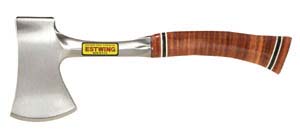
|
Single Bit Axe:Used for building fences, cutting small trees and construction work. This very versatile tool should not be used as a sledge hammer on wedges or iron stakes. Handles are usually of hickory, 36 inches long, oval in cross section and shaped for good balance.
(Common Tools-Axes) |

|
Double Bit Axe:Used to cut small trees, trim logs and tops. Its two cutting edges should not be left in a vertical position because of the safety hazard. The 36 inch handle is oval and straight.
(Common Tools-Axes) |
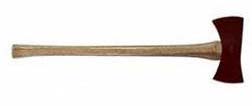
|
Flat Pry Bar:Contoured flat bar, with beveled nail slots at each end. Also called a Wonder Bar (Stanley brand name).
(Common Tools-Bars) |

|
Ripping Bar:Usually it is of octagon tempered steel. Used for demolition and pulling large nails. Also called a Wrecking Bar.
(Common Tools-Bars) |
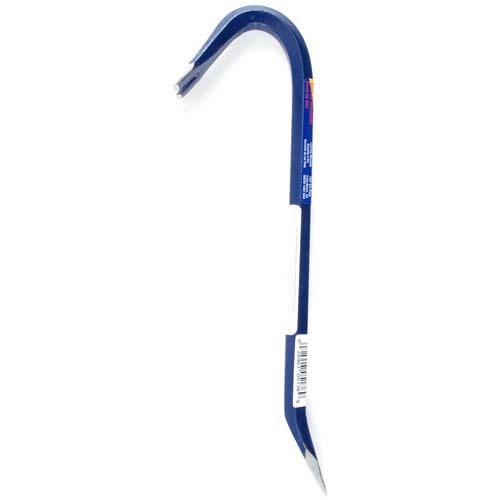
|
Pry or Fitting Bar:It has a long round taper at one end and a curved pry hook at the other.
(Common Tools-Bars) |
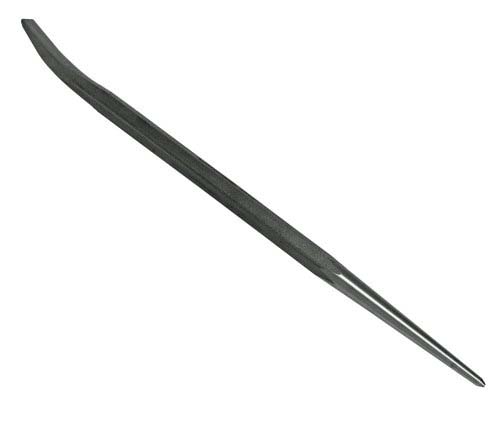
|
Crow Bar:It is normally four or five feet long with one end tapered round and the other end with a chisel point.
(Common Tools-Bars) |
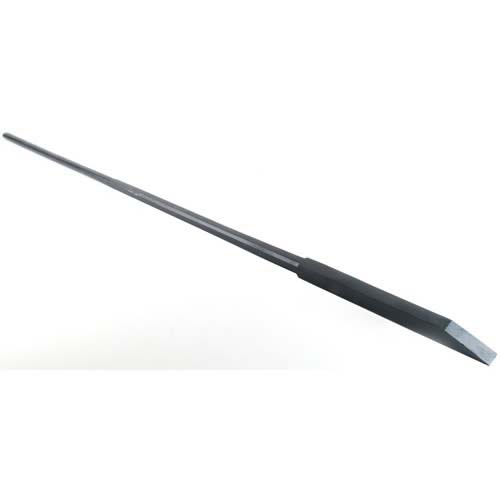
|
Parts Brush:Metal handle is usually sealed at both ends to enable brush to float in solvent to prevent losing brush in solvent tank.
(Common Tools-Brushes) |

|
Push Broom:Handles are 7/8 inch in diameter 4 to 5 feet long and are threaded into broom body or bolted on.
(Common Tools-Brushes) |
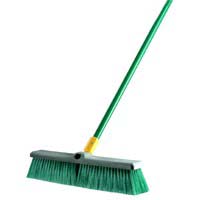
|
Wire Brush:Used for cleaning metal parts to be welding, cleaning machinery parts and removing slag and rust.
(Common Tools-Brushes) |
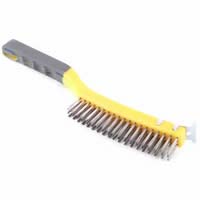
|
Bench Brush:The overall length is 16 inches.
(Common Tools-Brushes) |
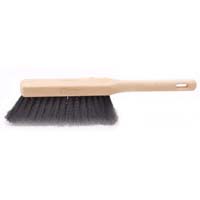
|
Pipe Clamp:A clamp made with a steel pipe.
(Common Tools-Clamps) |

|
Bar Clamp:Bar type clamp has quick non slip adjustment to approximate size; then screws tight to apply pressure.
(Common Tools-Clamps) |
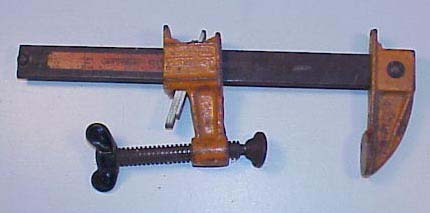
|
"C" Clamp Locking Pliers:Used for clamping irregular shapes quickly and firmly when welding or fastening.
(Common Tools-Clamps) |
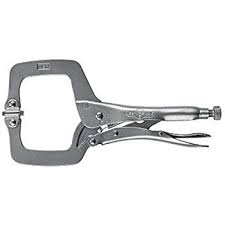
|
Locking Welding Clamp:Works well when clamping two pieces adjacent to each other or at 90 degree angles.
(Common Tools-Clamps) |
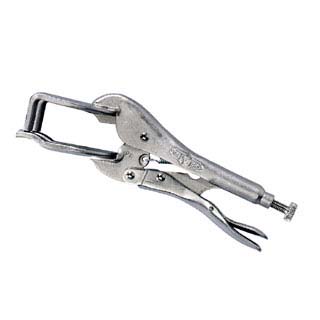
|
"C" Clamp:The screw has a sliding bar or a thumb screw at one end and usually a ball and socket pad at the other Sizes range from 2 to 12 inches.
(Common Tools-Clamps) |

|
Face Shield:Eye protection that covers the entire face. Often used with safety glasses when full protection of the face is required.
(Common Tools-Miscellaneous) |

|
Safety Glasses:Eye protection that covers eyes only. Safety glasses have side shields. The California State Educational Code states that all students, teachers, and visitors in a school shop must wear eye protection.
(Common Tools-Miscellaneous) |
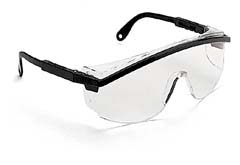
|
Safety Goggles:Eye protection that covers eye glasses.
(Common Tools-Miscellaneous) |

|
Hog Ringer:It is some what like a pair of pliers except the jaws of the ringer has special slots for holding the ring.
(Common Tools-Miscellaneous) |
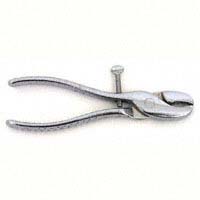
|
Air Compressor:Used for supplying compressed air for spray painting and for operating air tools at low pressures (less than 100 psi).
(Common Tools-Miscellaneous) |

|
Chain Saw:Most chain saws are gasoline powered, but smaller pruning saws can be electric or hydraulically powered.
(Common Tools-Miscellaneous) |
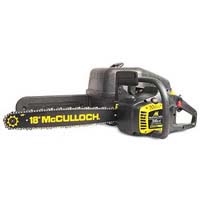
|
Contractors Wheelbarrow:Used widely in the construction industry. Typical capacity 1/5 cubic yard. Wheel is pneumatic.
(Common Tools-Miscellaneous) |

|
Bolt Cutter:The toggle and lever joints develop great mechanical advantage. Commonly used to cut bolts, chain, and reinforcing bar.
(Common Tools-Miscellaneous) |

|
Staple Gun:Heavy duty and light utility models are available driving 3/16 to 1/2 inch staples.
(Common Tools-Miscellaneous) |
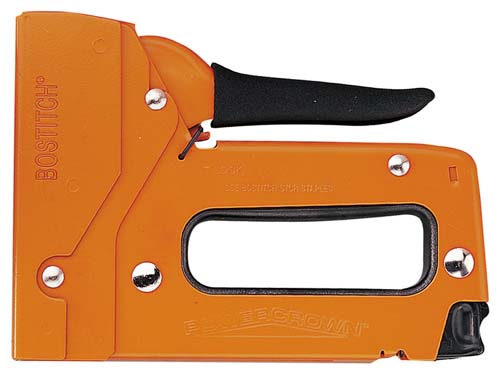
|
Battery Pliers:Used for removing battery terminals. The end clearance prevents cell-cover damage.
(Common Tools-Pliers) |
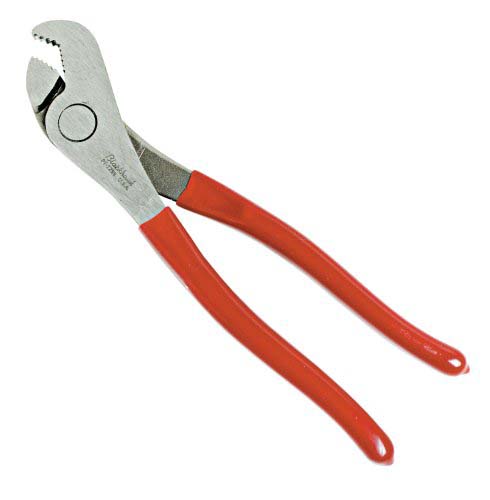
|
Locking Pliers:Locks with a toggle action that holds until the lever is opened. Commonly called Vise-Grip pliers.
(Common Tools-Pliers) |

|
Water Pump Pliers:The jaws are adjustable to 2 inches.
(Common Tools-Pliers) |

|
Slip Joint Combination Pliers:Used for general purpose work, for holding flat or round stock, and for cutting soft wires.
(Common Tools-Pliers) |

|
Diagonal Cutting Pliers:It has curved handles, lap joined; and diagonal cutting jaws.
(Common Tools-Pliers) |

|
Retaining Ring Pliers:User for remove and install internal and external retaining (snap) rings.
(Common Tools-Pliers) |
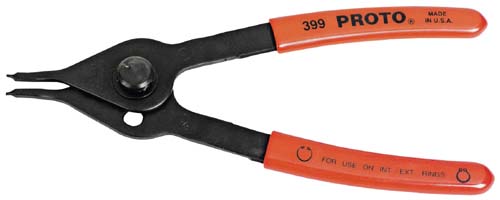
|
Fence Pliers:Grips between the handles hold the wire tightly while leverage is exerted against the fence post to stretch the wire fairly tight.
(Common Tools-Pliers) |

|
Prick Punch:The punch should be sharp and ground to 30 degrees.
(Common Tools-Punches) |

|
Hole Punch:These punches are used to make holes in gaskets and other materials. Also called a belt punch.
(Common Tools-Punches) |

|
Center Punch:It is manufactured in various sizes and lengths.
(Common Tools-Punches) |

|
Drift Punch:The shank is tapered.
(Common Tools-Punches) |

|
Pin Punch:This punch has a long, straight shank, the diameter of which designates the size. Used to remove bolts and pins.
(Common Tools-Punches) |
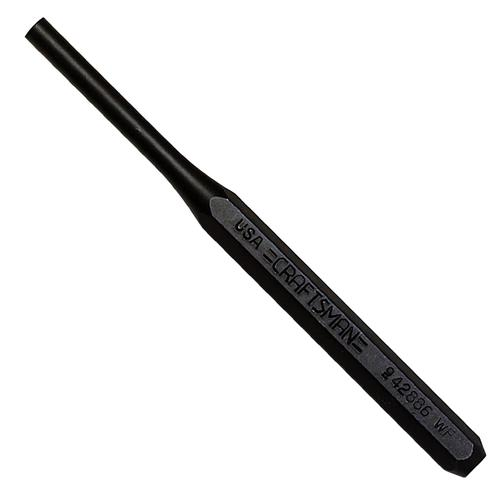
|
Leather Punch:The handles are similar to pliers. Used to punch holes in soft materials like leather and rubber.
(Common Tools-Punches) |
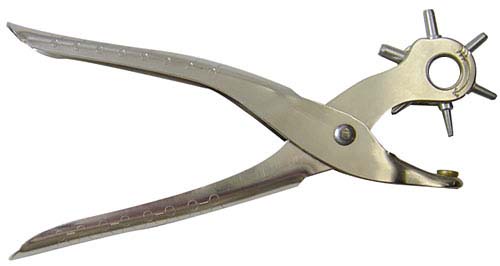
|
Slotted Screwdriver:Used mostly in woodworking applications.
(Common Tools-Screwdrivers) |

|
Torx Head Screwdriver:Also used on appliances, lawn and garden, and electronic equipment.
(Common Tools-Screwdrivers) |

|
Stubby Screwdriver:It comes in slotted and Phillips, and has a blade length of 1 1/4 to 1 1/2 inches long.
(Common Tools-Screwdrivers) |

|
Square Recess Screwdriver:Each screwdriver is color coded for easy size identification. Commonly used to drive deck screws and used with electrical devices.
(Common Tools-Screwdrivers) |

|
Screwdriver Bits:Available in slotted, Phillips, square, and torx drives for power screwdrivers. Shank is hexagonal.
(Common Tools-Screwdrivers) |

|
Phillips Screwdriver:Always select the correct size for the correct application.
(Common Tools-Screwdrivers) |

|
Offset Screwdriver:Used where it is difficult to reach the screw head with a common or standard screwdriver.
(Common Tools-Screwdrivers) |
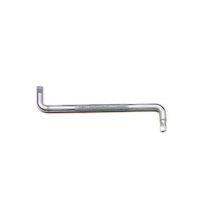
|
Nut Drivers:This is a very popular tool in the electrical and sheet metal industry.
(Common Tools-Screwdrivers) |

|
Clutch Driver:This is a specialty drive that fits screws used in mobile homes, boats, recreational vehicles, and electric motors.
(Common Tools-Screwdrivers) |
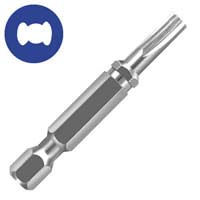
|
Square Point Shovel:Used for scooping materials such as sand and gravel. Typically the handle about 50 inches long.
(Common Tools-Shovels, Rakes, Picks) |

|
Round Point Shovel:A shovel used for digging. Typical handle length approximately 50 inches.
(Common Tools-Shovels, Rakes, Picks) |

|
Scoop Shovel:The handle can be a short capped ferrule “0” type or 54 inch long handle.
(Common Tools-Shovels, Rakes, Picks) |

|
Irrigating Shovel:The same as the round point except the blade is almost straight with the handle.
(Common Tools-Shovels, Rakes, Picks) |

|
Bow Rake:Has 15, 2 1/2 inch pointed teeth attached at 90 degrees to a 5 foot ferruled handle.
(Common Tools-Shovels, Rakes, Picks) |
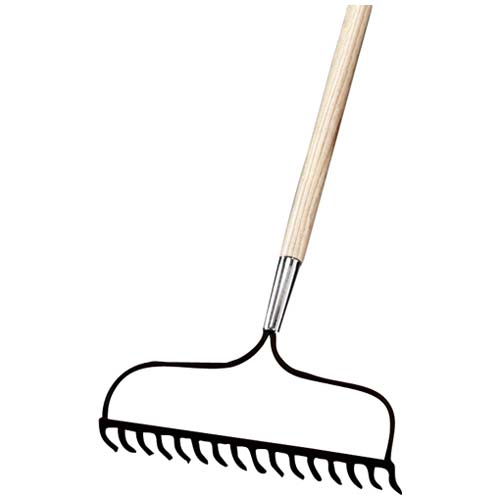
|
Pick Mattocks:Similar to the cutter mattocks except one end of the blade comes to a sharp point for breaking or digging in hardpan or very hard soil.
(Common Tools-Shovels, Rakes, Picks) |
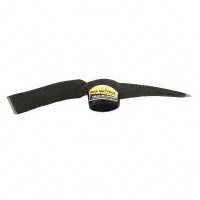
|
Cutter Mattocks:The blades ends are rotated 90 degrees and oval hole is in the center for the handle which is sold separate.
(Common Tools-Shovels, Rakes, Picks) |
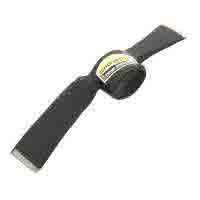
|
Clay Picks:The handles for all picks are 32 inches long and are larger at the head or blade end.
(Common Tools-Shovels, Rakes, Picks) |
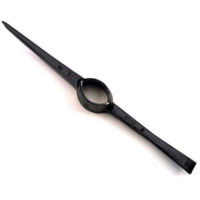
|
Posthole Auger:It is operated by rotating the handle.
(Common Tools-Shovels, Rakes, Picks) |
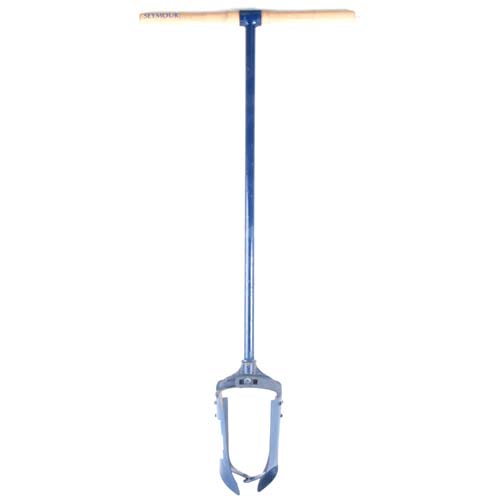
|
Posthole Digger:It is operated by thrusting the points into the soil and spreading the handles to remove the soil. Also called a Clam Shell.
(Common Tools-Shovels, Rakes, Picks) |
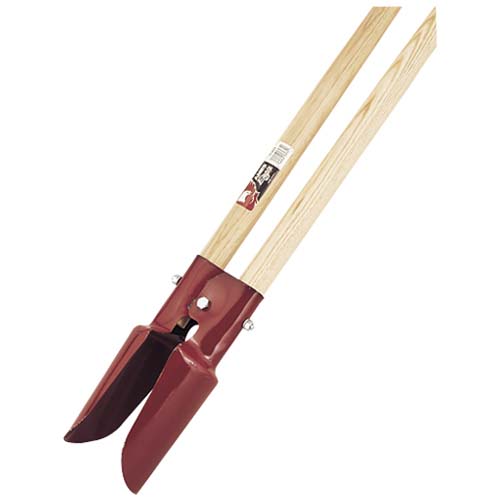
|
Woodworker's Vise:The flat smooth jaws open up to 12 inches. Jaws may be lined with wood.
(Common Tools-Vises) |
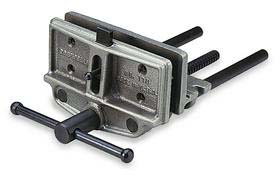
|
Machinist's Vise:A bench mounted vise for metal with a swivel base and replaceable jaws. It should not be used for hammering or bending metal. Also called a Bench Vise.
(Common Tools-Vises) |

|
Drill Press Vise:Drilling is safe and more accurate when a vise is used, and fewer drill bits are broken.
(Common Tools-Vises) |
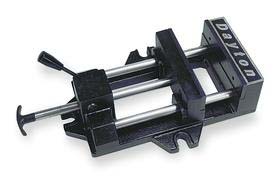
|
Open End Wrench:Both ends of the wrench are open but are of different sizes.
(Common Tools-Wrenches) |

|
Combination End Wrench:The reason for the popularity of this wrench is that it has the advantage of having both open and box ends.
(Common Tools-Wrenches) |

|
Tubing Wrench:The box at each end of the wrench is 6 point only. Also called a flare nut wrench.
(Common Tools-Wrenches) |
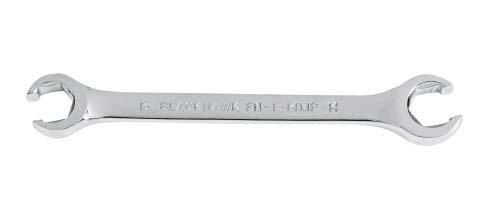
|
Box End Wrench:Wrench is available in 12 and 6 point ends.
(Common Tools-Wrenches) |

|
Eight Point Socket:Has 8 points and is used on square nuts found on farm machinery.
(Common Tools-Wrenches) |

|
Deep Socket:The deep socket is made in standard, thin, and extra thin walls, with 6 or 12 point openings and with 3/8, 1/2 or 3/4 inch drive.
(Common Tools-Wrenches) |

|
Six Point Socket:The socket has 6 points inside to fit over hexagonal nuts.
(Common Tools-Wrenches) |
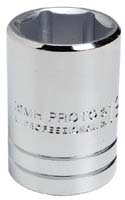
|
Twelve Point Socket:The socket has thin walls to fit in tight places.
(Common Tools-Wrenches) |

|
Flex Socket:This permits working at various angles.
(Common Tools-Wrenches) |
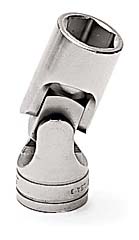
|
Extension Bar:Used to connect, the socket wrench to the ratchet handle to give working clearance, and are 3 to 20 inches long.
(Common Tools-Wrenches) |

|
Ratchet Handle:The ratchet speeds up the work. Common drive sizes 1-4”-3/4”.
(Common Tools-Wrenches) |

|
Speed Handle:Used to rapidly remove a nut or bolt. Common drive sizes 1-4”-3/4”.
(Common Tools-Wrenches) |

|
Slide Bar Handle:Used as a “T” or “L” handle and is normally used with the extension.
(Common Tools-Wrenches) |

|
Flex Handle:The end that fits into the socket is swivel hinged, and the other end has a hole with a sliding cross bar to permit use of the wrench at an angle.
(Common Tools-Wrenches) |

|
Socket Adaptor:Allows the use of larger drive sockets with smaller socket drives; i.e., 1/2 inch drive socket and 3/8 inch drive ratchet.
(Common Tools-Wrenches) |

|
Universal Joint:It makes work possible in restricted places where the wrench cannot be aligned with the bolt.
(Common Tools-Wrenches) |
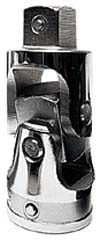
|
Hex Key:This wrench is made of hexagon stock with one end bent to a 90 degree angle.
(Common Tools-Wrenches) |
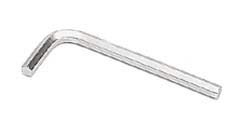
|
Chain Wrench:It is made in several sizes ranging from 13 ¾ to 87 inches long, and will handle pipe from 1/8 to 18 inches in diameter.
(Common Tools-Wrenches) |

|
Strap Wrench:The adjustable strap is useful in rotating large diameter objects like filters.
(Common Tools-Wrenches) |

|
Adjustable Wrench:Size is designated by inches in length.
(Common Tools-Wrenches) |

|
Sponge Rubber Float:Must be dipped continuously in water when working plaster to keep the plaster from adhering to the rubber.
(Concrete Tools And Supplies) |
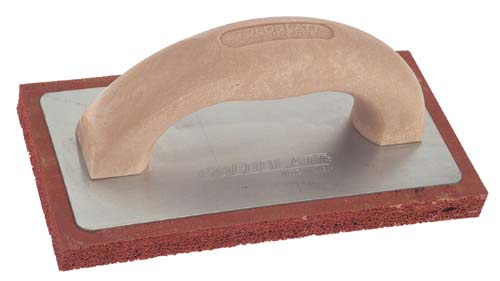
|
Mud Pan:Used mostly with small trowels or putty knifes.
(Concrete Tools And Supplies) |
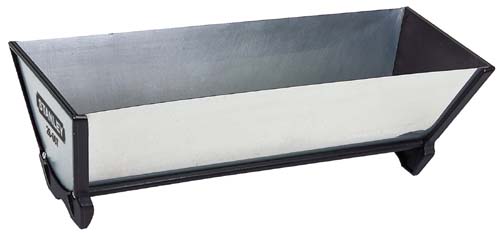
|
Corner Trowel:Size is 2 1/2 by 2 1/2 wide and 6 inches long. Used to finish corner in curbs, steps, etc. The handle placement determines if the trowel is outside or inside. Outside corner trowel is also called a step trowel.
(Concrete Tools And Supplies) |
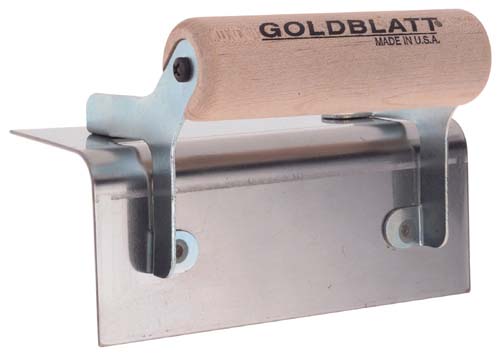
|
Mortar Hoe:It also has a 5 1/2 foot handle and holes in the hoe to aid mixing.
(Concrete Tools And Supplies) |

|
Hawks:The size is 13 x 13 inches square. Use to carry mortar.
(Concrete Tools And Supplies) |

|
Concrete Tampers:A tubular steel frame handle is attached to the top which allows a person to operate the tamper while walking in the concrete. Also called a Jitterbug.
(Concrete Tools And Supplies) |

|
Groover:It is 2 7/8 inches wide and 6 inches long with the ridge being 1/2 inch deep and 1/2 inch wide. Use to place groves in concrete slabs.
(Concrete Tools And Supplies) |

|
Concrete Edger:The ends may be curved up slightly. Used to finish the edges of concrete.
(Concrete Tools And Supplies) |
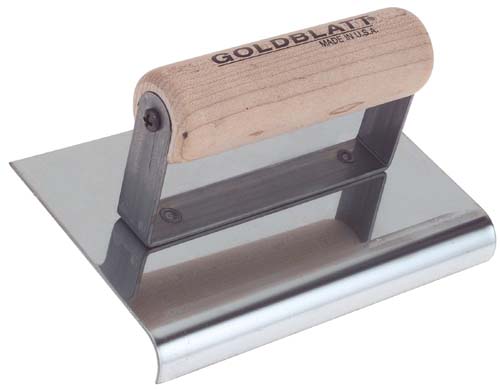
|
Fresno Trowel:This large finish trowel also has a long detachable handle.
(Concrete Tools And Supplies) |

|
Finishing Trowel:The finishing trowel is made of steel and is 4 inches wide by 14 inches long.
(Concrete Tools And Supplies) |

|
Reinforcing Bar:Available in 20, 30, and 40 foot lengths. Common sizes (diameter) of 3/8" to 1" are use in small construction projects.
(Concrete Tools And Supplies) |

|
Star Drill:It is operated by striking with a hammer while rotating by hand.
(Concrete Tools And Supplies) |

|
Masonry Bit:Used to drill in brick, block, and concrete. The tip is treated with tungsten carbide to resist heat and wear.
(Concrete Tools And Supplies) |
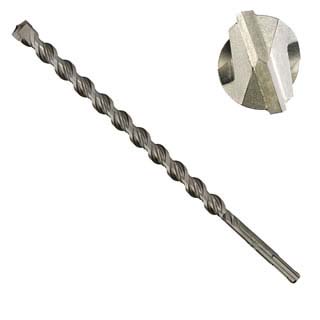
|
Bull Float:A large float with a long detachable handle. Made from wood or magnesium. Common sizes are 8 inches wide by 36 or 48 inches long.
(Concrete Tools And Supplies) |

|
Hand Float:It is 4 to 5 inches wide and 13 inches long. Floats are used for rough finishing.
(Concrete Tools And Supplies) |

|
Brick Chisel:Blade is 3 1/2 inches wide, overall length is 7 inches.
(Concrete Tools And Supplies) |
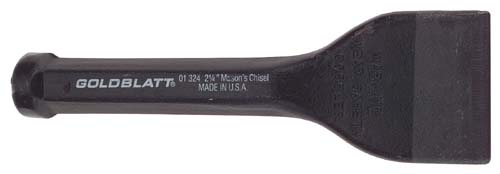
|
Brick Trowel:It is pointed and measures 4 ¾ inches by 11 inches.
(Concrete Tools And Supplies) |

|
Brick Jointer:The jointer is bent at each end at about 20 degrees to allow the mason to use one end as a handle and the other as a jointer. The tool is used to finish the joints between bricks.
(Concrete Tools And Supplies) |

|
Brick Layer's Hammer:The wedge shaped end is for scoring and cutting brick, and the other end is for tapping bricks into place when leveling.
(Concrete Tools And Supplies) |

|
Lampholder:A plastic or porcelain device that holds a lamp.
(Electrical-Boxes and Devices) |

|
Junction Box:Usually made of metal in square or octagon shaped boxes.
(Electrical-Boxes and Devices) |
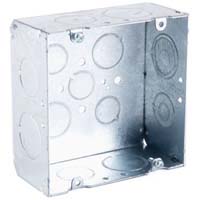
|
Cord Connectors:This connecting body is designed to accommodate the cord cap and is sometimes called a female plug.
(Electrical-Boxes and Devices) |
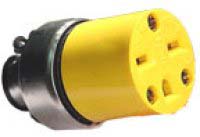
|
Cord Cap:It is some times called a male plug. Used on extension cords and power tool cords.
(Electrical-Boxes and Devices) |
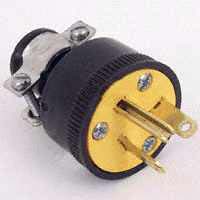
|
Duplex Receptacle:Receptacles may be installed in outlet boxes flush with the wall or in surface mounted boxes or junction boxes.
(Electrical-Boxes and Devices) |
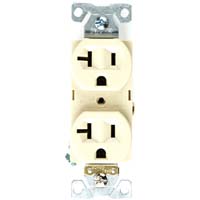
|
Switch Box:Comes with knockouts for non-metallic sheathed cable or electrical metallic tubing.
(Electrical-Boxes and Devices) |
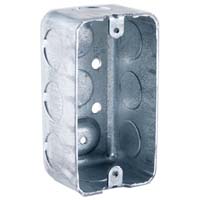
|
Three-Way Toggle Switch:Traveler or go between wires connect to lighter colored brass screws; hot wire is connected to the darker colored brass screw.
(Electrical-Boxes and Devices) |
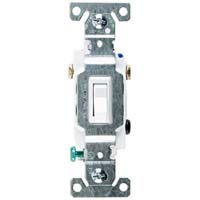
|
Toggle Switch:When the toggle switch is pushed up the service is on and off when pushed down.
(Electrical-Boxes and Devices) |

|
Flexible Conduit:It consists of a heavily zinc coated steel strip wound spiraling, with interlocked construction permitting greater flexibility.
(Electrical-Conduit) |

|
EMT Connector:Used to connect EMT conduit to a box, panel, or other threaded fitting.
(Electrical-Conduit) |

|
EMT Coupling:A compression fitting used to join EMT conduit.
(Electrical-Conduit) |
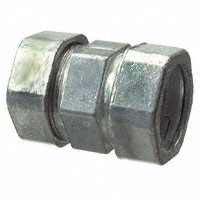
|
Electrical Metallic Tubing:A thin walled conduit. Commonly abbreviated as EMT. It is coupled with special fittings and is smooth inside. Manufactured in 10 foot lengths. Common sizes 1/2"-2". Approved for indoor use.
(Electrical-Conduit) |
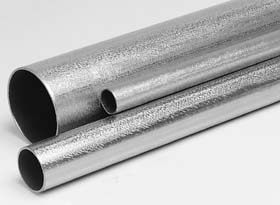
|
EMT Sweep:The difference being, it is made of thin wall conduit and has no threads.
(Electrical-Conduit) |
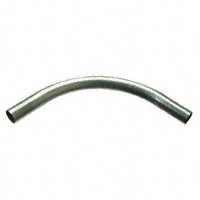
|
Ridged Entrance Ell:Has female thread on each end and has removable cap for access to wire for splicing or pulling.
(Electrical-Conduit) |
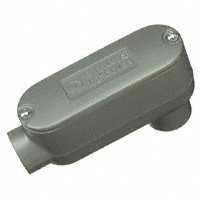
|
Ridged Elbow or Sweep:Sizes range from 1/2 to 2 inch.
(Electrical-Conduit) |
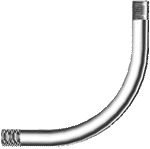
|
Ridged Coupling:Made of galvanized steel.
(Electrical-Conduit) |
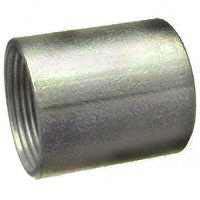
|
Ridged Conduit:It is available in galvanized and enamel finishes.
(Electrical-Conduit) |

|
Service Entrance Cap:Made of cast aluminum or PVC.
(Electrical-Conduit) |
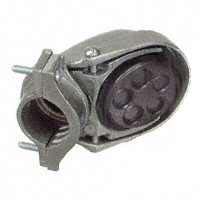
|
Raintite Hub:Made of cast aluminum and has a flange with pre-drilled holes for mounting to panel, and threaded inlet for conduit.
(Electrical-Conduit) |
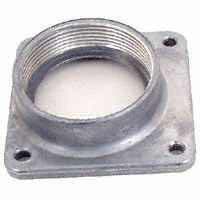
|
PVC Elbow or Sweep:It has a long radius and is connected by gluing couplings on elbow and pipe.
(Electrical-Conduit) |
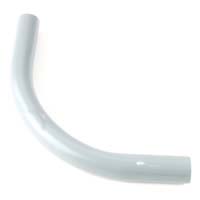
|
PVC Male Adaptor:Adapts PVC conduit to a threaded fitting for connecting to a box, panel , etc.
(Electrical-Conduit) |
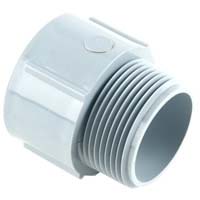
|
PVC Coupling:Used to connect PVC conduit, must be glued and once connected cannot be removed.
(Electrical-Conduit) |

|
PVC Conduit:PVC conduit is used inside, outside or underground. Gray in color. Glued connections make it waterproof.
(Electrical-Conduit) |
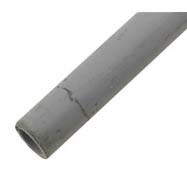
|
PVC Pull Elbow:Used to make 90 degree bends and has removable cap for splicing or pulling wire. Glues to PVC conduit. Types denote the location of the cover (e.g. LB, LR)
(Electrical-Conduit) |

|
Armored Cable:This cable must run from box to box without splices.
(Electrical-Supplies) |
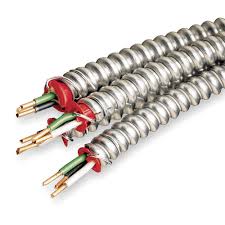
|
Circuit Breaker:Used to protect the wire in a circuit. Rated in amps.
(Electrical-Supplies) |

|
Knife Fuse:The knife fuse is made in several sizes for service of 60 to 600 amps and is not interchangeable with cartridge fuses or knife fuses of different capacities.
(Electrical-Supplies) |

|
Solderless Connector:Used where a permanent connection is desired. Connectors can be insulated or un-insulated. Commonly used for wiring on mobile equipment.
(Electrical-Supplies) |

|
Wire Nut:Used to connect AC wires. Color coded to denote capacity.
(Electrical-Supplies) |
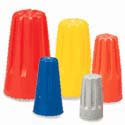
|
Plastic Covered Electric Wire:The larger the number the smaller the wire.
(Electrical-Supplies) |
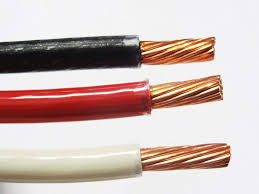
|
Plastic Tape:It is used alone without friction tape.
(Electrical-Supplies) |

|
Electric Cord:A flexible cable used for extension cords and connecting power tools. May be plastic (e.g. Type xx) or rubber covered (e.g.. Type SJ)
(Electrical-Supplies) |
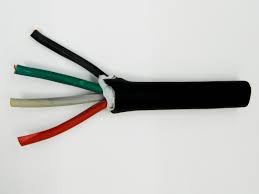
|
Conduit Straps:Conduit is placed in the curved portion and strap is secured by nails or screws. Single foot and double foot styles. Sized for EMT and rigid/PVC conduit.
(Electrical-Supplies) |
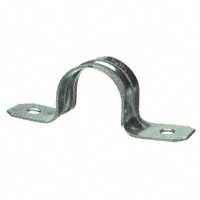
|
Core Solder:It is available in spools. Rosin core is used to solder wires and acid core to solder sheet metal.
(Electrical-Supplies) |
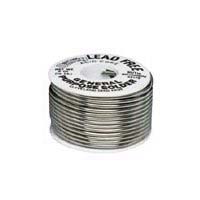
|
Friction Tape:Used over rubber insulating tape on wire Splices and is used to replace the outer braid.
(Electrical-Supplies) |
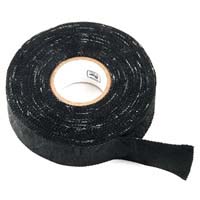
|
Ground Rod:It is connected to the electrical service box or meter can by a shielded ground wire and a ground clamp.
(Electrical-Supplies) |
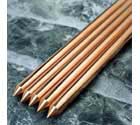
|
Ground Rod Clamp:Connects a ground wire to a grounding rod, reinforcing bar, or metal water pipe. This provides for a good ground in the event of a power spike or lightning strike.
(Electrical-Supplies) |
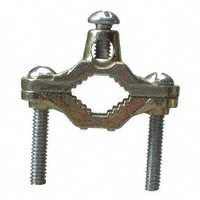
|
Insulated Staple:Commonly used for low voltage wire used in applications such as door bells or sprinkler controllers. It should not be used 120-volt lines.
(Electrical-Supplies) |

|
Cartridge Fuse:It is a cylinder shaped like a cartridge case and has metal ferrules at each end and a soft fusible element inside.
(Electrical-Supplies) |
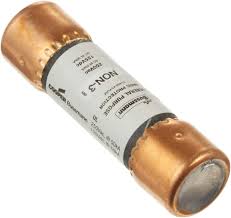
|
Strap Nail Drive:Made of die cast zinc, it is driven into wood with a hammer with conduit resting in curved end.
(Electrical-Supplies) |
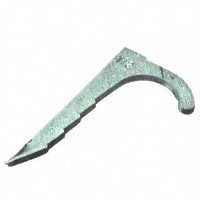
|
Non-Metallic Clamp:The cable is secured by means of a bracket tightened with screws. Used to secure a NM cable to a box.
(Electrical-Supplies) |
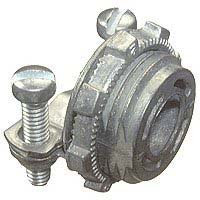
|
Non-metallic Cable Staples:Staples used to secure type NM cable to wood.
(Electrical-Supplies) |
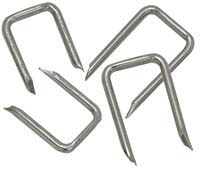
|
Non-Metallic Cable:A cable with a plastic cover used for residential indoor wiring. Commonly found with 3 and 4 conductor in sizes 14-6.
(Electrical-Supplies) |
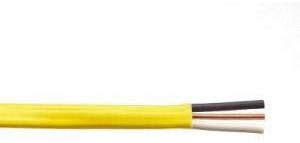
|
UF Cable:A solid plastic covering is used on this cable making it suitable for direct burial of the cable.
(Electrical-Supplies) |
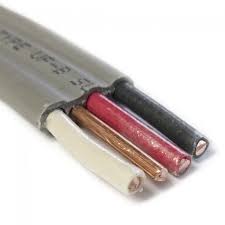
|
Single Conductor:A single conductor with thermal plastic insulation. Wire may be solid or stranded. Typical types are TW and THHN. Common sizes 14-0
(Electrical-Supplies) |
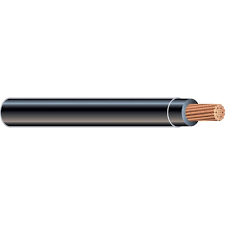
|
Service Panel:Used to distribute power in a building. Contains a main disconnect and circuit breakers.
(Electrical-Supplies) |
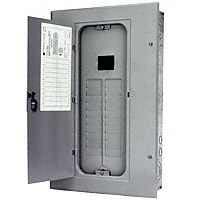
|
Rubber Tape:Used on high voltage connections. It is covered with friction tape or plastic tape.
(Electrical-Supplies) |

|
Multi-Testers or Volt-Ohm Meter:An analog or digital meter that commonly will measure AC volts, DC volts, Ohms, and milli-amps.
(Electrical-Tools) |

|
Voltage Tester:Used for testing voltage on electrical outlets, fuse clips, and circuit breakers will test voltage from 120 to 600 volts.
(Electrical-Tools) |
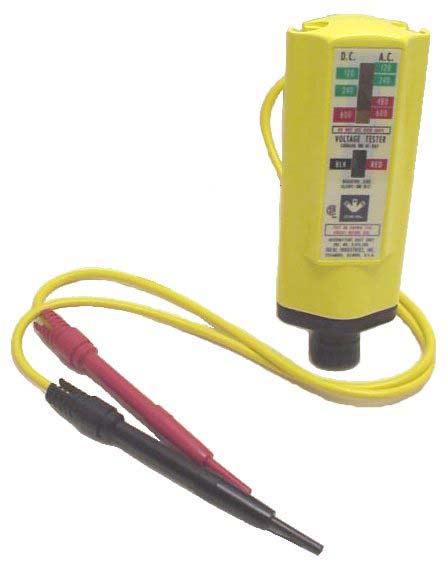
|
Continuity Tester:A device used to the continuity of a circuit.
(Electrical-Tools) |
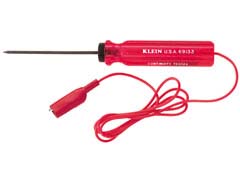
|
Soldering Gun:It is fitted with a replaceable tip and operates on 115-volt AC. Used primarily for soldering wires.
(Electrical-Tools) |
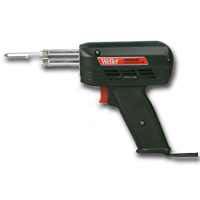
|
Non-Metallic Cable Ripper:Made of a thin “U” shaped metal piece.
(Electrical-Tools) |
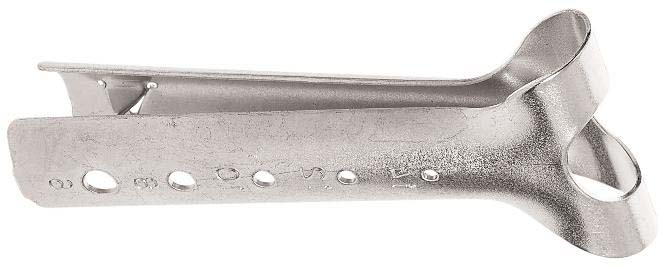
|
Fuse Puller:Made of plastic to prevent electrician from being shocked while installing or removing fuses.
(Electrical-Tools) |
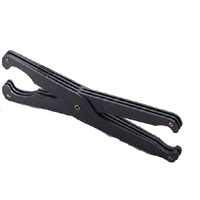
|
Wire Stripper:Used to strip plastic coating from solid electrical wires without damaging the wire .Can be adjusted to be used on various wire sizes.
(Electrical-Tools) |
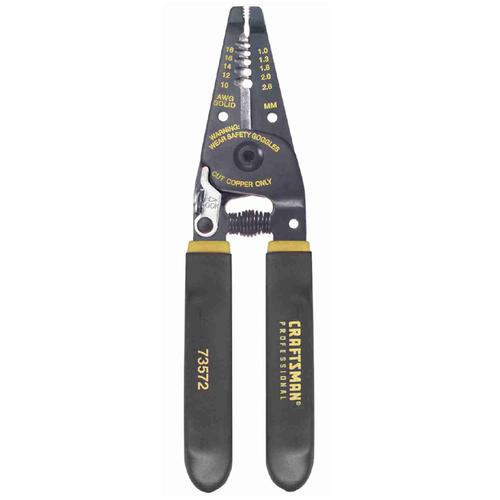
|
Lineman's Pliers:They are used on both bare and insulated wire. Note: These tools are also used for fence work and tying concrete rebar.
(Electrical-Tools) |
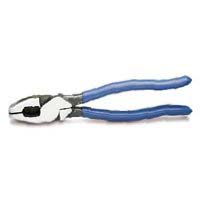
|
Wire Stripper And Crimping Tool:Used for stripping wire, cutting wire and crimping wire terminals on stripped wire ends.
(Electrical-Tools) |

|
Knockout Punch:Sizes range from 1/2 to 2 1/2 inches. Used to create a hole in panel for connecting conduit.
(Electrical-Tools) |
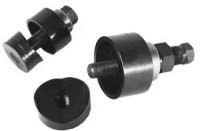
|
Electric Soldering Iron:It has a replaceable copper tip. Soldering irons are sized from very light duty for soldering fine wires to heavy duty for soldering sheet metal.
(Electrical-Tools) |

|
Hickey:The Hickey or bender is used for short radius bends.
(Electrical-Tools) |
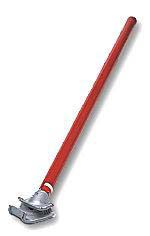
|
Conduit Bender:This enables an electrician to make accurate 45 and 90 degree bends. Bender may be designated for EMT or rigid conduit.
(Electrical-Tools) |
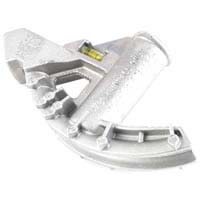
|
NM Cable Cutter:A cutter for cutting Type NM cable.
(Electrical-Tools) |
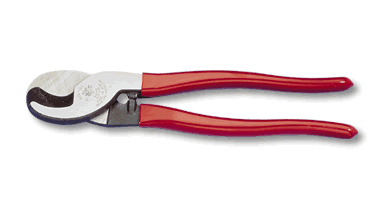
|
Fish Tape:Fish tapes come in 25, 50 and 100 foot lengths.
(Electrical-Tools) |
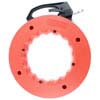
|
Long Nose Pliers:Also used for stripping wire, making eyes in wire and holding wire in place while inserting screws.
(Electrical-Tools) |
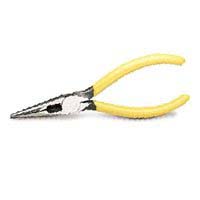
|
Cap Screws:It resembles a short bolt with a hexagon head with either coarse, fine, or metric thread. Term describes machine bolts and machine screws.
(Fasteners) |

|
Toggle Bolt:When the screw is tightened a firm anchorage is made.
(Fasteners) |

|
Machine Screw:The head is slotted for a screwdriver and may be either round of flat. Typical sizes 4-12.
(Fasteners) |

|
Plow Bolt:No wrench is necessary to hold the bolt head.
(Fasteners) |
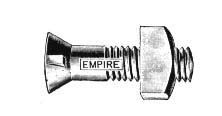
|
Machine Bolt:The head and nut may be square or hexagon shaped.
(Fasteners) |
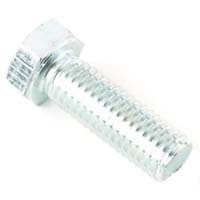
|
Lag Bolt:The bolt has a square or hex head with a tapered wood screw on the other end. Common sizes 1/4 to 1/2 in diameter, 2" to 12" long. Also called a Lag Screw.
(Fasteners) |

|
Grade 2 Bolt:Soft bolt commonly used for landscape applications and other applications where strength is not important.
(Fasteners) |

|
Carriage Bolts:Never use a washer under the head. Use to bolt wood.
(Fasteners) |

|
Eye Bolt:It has an eye on one end and coarse or fine threads on the other.
(Fasteners) |

|
Grade 5 Bolt:Mildly hardened bolt used commonly in machinery and equipment applications. Three markings on the head.
(Fasteners) |

|
Grade 8 Bolt:Hardened bolt used where high tensile strength is required. 6 markings on the head.
(Fasteners) |

|
Cotter Pin:This prevents the nut from working loose. Also called a Cotter Key.
(Fasteners) |

|
Corrugated Fastener:The size is 1/4 to 1 inch in depth and 2 to 7 corrugations. Used to fasten wood.
(Fasteners) |

|
Box Nail:Roughly speaking, d equals 1/4 inch in length, but this is not constant. The shank is smaller in diameter than the common nail to prevent splitting of the wood. Common sizes 2d to 16d
(Fasteners) |

|
Duplex-Head Nail:The point is sharp, and there are two heads, one above the other, to make removal easy. Common sizes 6d, 8d, 16d.
(Fasteners) |

|
Common Nail:Roughly speaking, d equals 1/4 inch in length, but this is not constant. The shank is larger in diameter than the box nail making the nail less likely to bend. Common sizes 2d – 20d. Sizes larger then 20s are often called spikes.
(Fasteners) |

|
Finish Nail:The sizes range from 2d to 20d. The nail is designed to be counter sunk and the hole filled.
(Fasteners) |

|
Galvanized Nail:Common, box, and finish nails are available for exterior use with a galvanized coating. The coating may be hot dipped (thicker) or electro-plated (EG).
(Fasteners) |

|
Spiral Shank Nails:Designed for the construction and repair of wood pallets. These spiral shank nails are also good for re-nailing wagon beds, trailers.
(Fasteners) |

|
Wire Brad:The size is expressed in wire gauge and ranges from 1/4 to 1 1/2 inches long.
(Fasteners) |
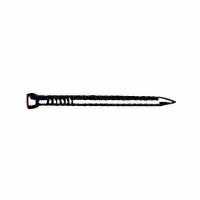
|
Cement Coated Nails:Sizes range from 2d to 16d. Commonly found in a green coating in 8d and 16d ("sinkers").
(Fasteners) |

|
Blue Plaster Board Nail:The range in size is 1 to 1 1/2 inches.
(Fasteners) |

|
Aluminum Roofing Nails:Sizes range from 1 to 1 1/2 inches long.
(Fasteners) |

|
Lead-Head Nails:Lead washer is to prevent oxidation between the head of the nail and the galvanized roofing and also prevents leakage.
(Fasteners) |

|
Galvanized Shingle Nail:The 3d is generally used for shingling.
(Fasteners) |

|
Galvanized Roofing Nail:The head is about 1/2 inch in diameter, and the length ranges from ¾ to 2 inches.
(Fasteners) |

|
Furring Nail:This allows the wire to become a reinforcing agent and the nails hold the plaster to the wall.
(Fasteners) |

|
Wing Nuts:Used where hand tightening (no wrench) is desired such as inspection covers.
(Fasteners) |
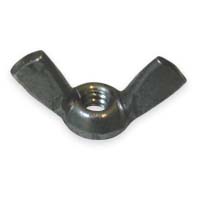
|
Square Nut:Used on farm implements with carriage bolts, machine bolts, stoves bolts and plow bolts.
(Fasteners) |

|
Cap Nut:A nut closed on one side to cover an exposed bolt.
(Fasteners) |
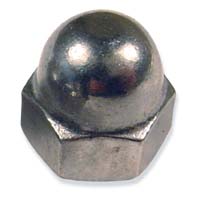
|
Castellated Hex Nut:Used with a cotter pin to prevent loosening or tightening. Top the nut is smaller in diameter than the base.
(Fasteners) |

|
Hex Nut:It may have NC, NF, or metric threads.
(Fasteners) |

|
Self-Locking Nuts:When tightened on a bolt the scored threads bite into the threads of the bolt preventing it from backing off.
(Fasteners) |
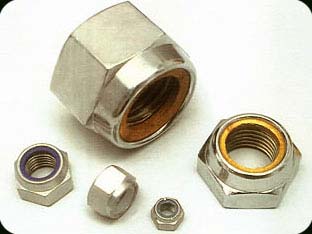
|
Slotted Hex Nut:It differs from the castellated nut in that there is no stepped-in castle-like top.
(Fasteners) |

|
Pop Rivet:A pop rivet tool is required to set the rivet.
(Fasteners) |
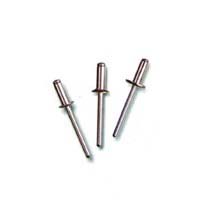
|
Pop Rivet Tool:Tool is adjustable to use the various sizes (diameter) of rivets available.
(Fasteners) |

|
Soft Iron Rivet:The size is based on length and diameter.
(Fasteners) |

|
Rivet Set:A rivet set is a small bar of steel with a hole drilled in the end to receive the rivet, and with a cup-like depression for forming a round head on the rivet.
(Fasteners) |
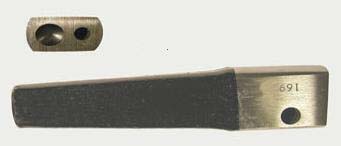
|
Sheet Metal Screws:Head types are flat, round, pan, oval and binding.
(Fasteners) |

|
Screw Hook:Can be screw into wood walls or concrete or masonry when pre-drilled and a plastic or lead anchor is used.
(Fasteners) |
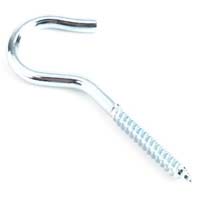
|
Torx Head Screws:The head is similar to the Phillips but having a six point star shaped opening in the center of the head rather than a four point star.
(Fasteners) |

|
Set Screw:When screwed into a set collar the cup point makes an indentation in the shaft preventing the collar from vibrating loose.
(Fasteners) |

|
Self Tapping Screws:Screw has a sharp point with coarse threads that make their own threads when screwed into a pre-drilled hole that is smaller than the diameter of the screw.
(Fasteners) |

|
Self Drilling Screws:No pre-drilling is necessary when using a self drilling screw.
(Fasteners) |

|
Wood Screws:A tapered screw with a round, oval, or flat head. The threaded portion of the screw is tapered with a very coarse thread and cuts its own thread as it is turned into the wood. Shown L-R oval head, round head, flat head Phillips, and flat head slotted.
(Fasteners) |
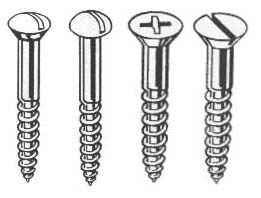
|
Drywall Screws:All Are Phillips Except the Hex Wafer Head. Used to fasten drywall. Bugle shaped flat head.
(Fasteners) |
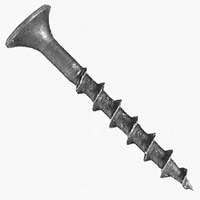
|
Deck Screws:A straight shank wood screw with a bugle head. Commonly made with a Phillips or square drive 2 1/2" of longer. Coated to prevent rusting.
(Fasteners) |
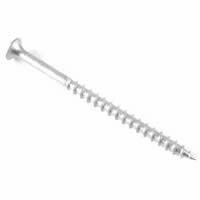
|
Screw Eye:It may be described as a screw with an eye or ring head.
(Fasteners) |

|
Flat Washers:Used to prevent the nut from rubbing and becoming imbedded in the bolted material. Also called a Cut Washer.
(Fasteners) |
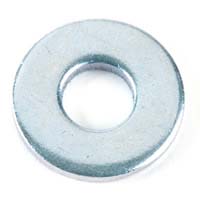
|
Fender Washers:The large holes are used for aligning or adjusting for proper fit.
(Fasteners) |

|
Lock Washer:It should not be used on wood.
(Fasteners) |
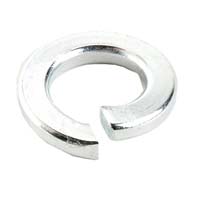
|
Finishing Washer:This is a chrome plated countersunk washer used with oval head wood or metal screws.
(Fasteners) |
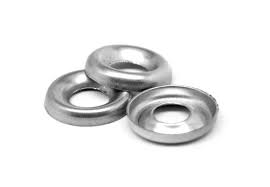
|
Malleable Iron Washer:Used where excess pressure or stress is exerted on wooden structures.
(Fasteners) |

|
Welded Wire Fence:Consists of 16 gauge galvanized wire spot welded rather than woven, and has 2 inch by 3 inch mesh.
(Hardware) |
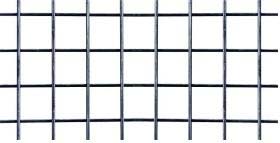
|
Turn Buckle:Turning the body tightens or loosens both at the same time.
(Hardware) |
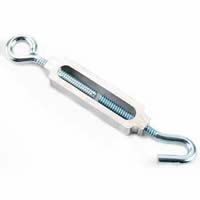
|
Woven Wire Fencing:The roll contains 20 rods of wire ranging from 32 to 47 inches wide.
(Hardware) |
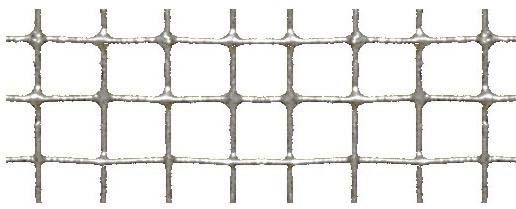
|
Wire Grip:Made of steel or malleable iron. Used to grip fencing wire when tightening
(Hardware) |
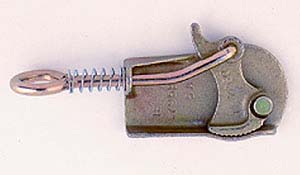
|
T-Post Insulator:The insulator is clipped to the steel post and the wire inserted into the plastic clip, thus preventing grounding of the electrical system.
(Hardware) |
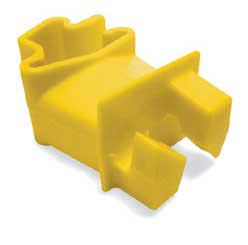
|
Steel Fence Posts:Round steel post with an anchor plate 12 inches from the bottom and comes in 3 to 6 foot lengths.
(Hardware) |

|
Staples:The length is stated in inches and fractions.
(Hardware) |
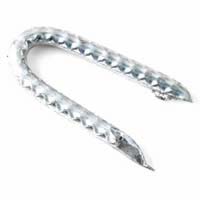
|
Poultry Wire Netting:The rolls are 50 to 150 feet long and from 1 1/4 to 4 feet wide.
(Hardware) |
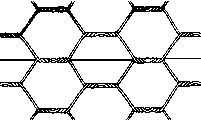
|
Nail On Electric Fence Insulator:Commonly a plastic insulator that nails to a wood post. Insulators hold electric fence conductors about 1" from the post.
(Hardware) |

|
Electric Fence Gate Handle:By pulling on the handle, tension can be released on the fence and it can be disconnected allowing entry.
(Hardware) |

|
Chain Link Fencing:Comes in 36 to 60 inch widths and 50 to 100 foot lengths. Also called Diamond Mesh.
(Hardware) |
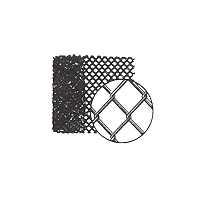
|
Come-A-Long:By working the ratchet handle the cable is tightened and moves the sheave block closer to the ratchet spool.
(Hardware) |
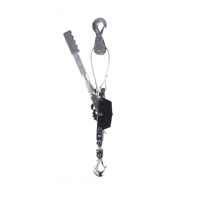
|
Barbed Wire:A spool of wire is 80 rods long.
(Hardware) |
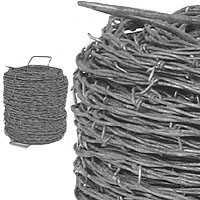
|
T Post:A steel post with an attached plate to help anchor the post. Commonly 5'-8' long.
(Hardware) |
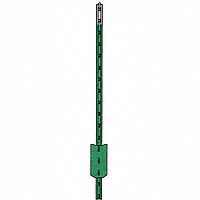
|
Smooth Galvanized Wire:It is made of smooth galvanized steel and is available in a variety of gauges.
(Hardware) |
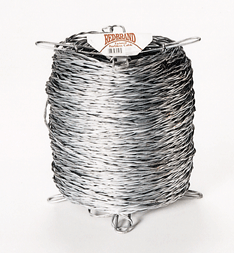
|
Wire Stretcher:It consists of two double sheave blocks specifically designed with hooks, holding lock, wire clamp and a rope.
(Hardware) |
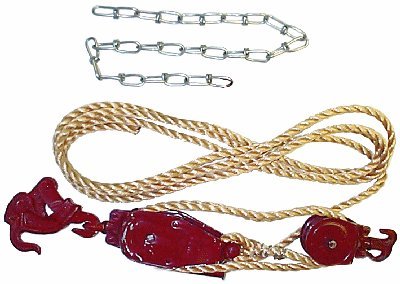
|
Butt Hinge:This hinge is available with fast pin or loose pin and is plain brass or steel or primed with paint.
(Hardware) |
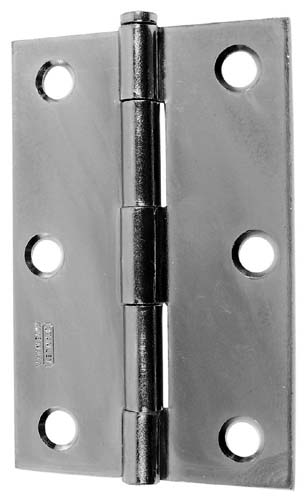
|
Strap Hinge:The size is measured from the hinge pin to the end of one strap.
(Hardware) |

|
Hinge Hasp:One end is like a strap hinge with a slot which folds over an eye or staple to accommodate a padlock.
(Hardware) |

|
Continuous Hinge:Same as the butt hinge except it comes in 8" to 8' lengths and is cut to length with a hacksaw. Also called a Piano hinge
(Hardware) |

|
Barrel Bolt:The other end, a separate piece is an eye which the bolt slides into when locking.
(Hardware) |
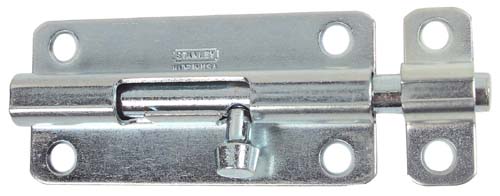
|
"T" Hinge:Size is measured from hinge pin to the end of the strap. Commonly use for gates ("T" fastens to post).
(Hardware) |
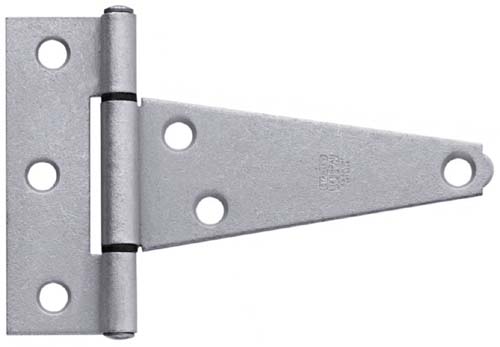
|
Gate Latch:The hook is inserted into the eye screw to latch.
(Hardware) |
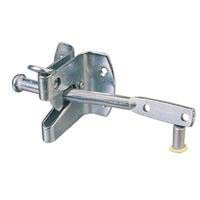
|
Torsion Spring:When the spring is wound up it exerts a twisting force.
(Hardware) |

|
Tension Spring:This spring can be extended, but exerts force by extending to pull back to its original length.
(Hardware) |

|
Compression Spring:A compression spring is one that exerts pressure when it is compressed.
(Hardware) |
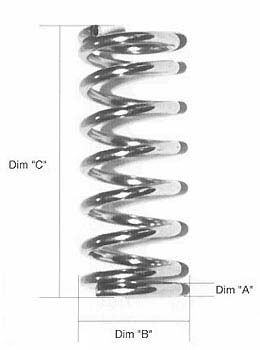
|
Fiberglass Tape:Lengths of 50', 100', 200, and 300' common. Tape maybe graduated in feet and inches, feet and 1/100', or metric.
(Measuring, Layout, and Surveying) |

|
Micrometer:Sizes range from 0 to 1 inch up to 12 inches.
(Measuring, Layout, and Surveying) |
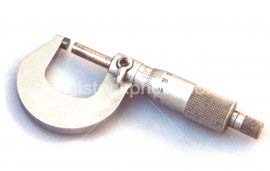
|
Steel Tape:It should be cleaned after using and kept free from rust.
(Measuring, Layout, and Surveying) |
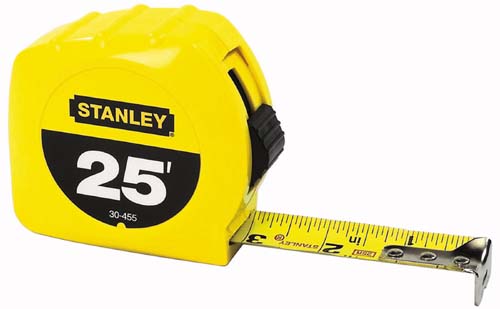
|
Measuring Wheel:Used to measure long distances such as field boundaries or road length where high accuracy is not required.
(Measuring, Layout, and Surveying) |
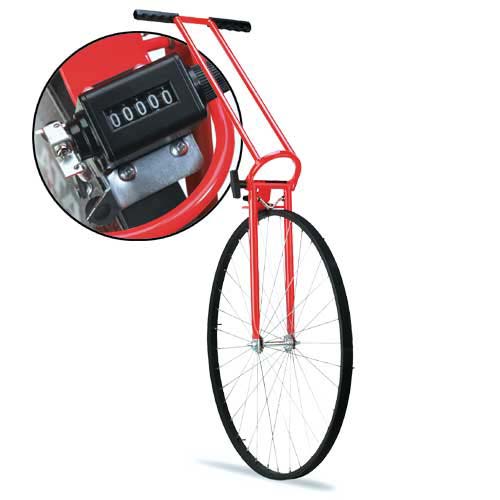
|
Rafter Square:An aluminum square marked for cutting rafters and angles. Also can be used as a guide for cross cutting with a circular saw. Small size will fit in a nail pouch.
(Measuring, Layout, and Surveying) |
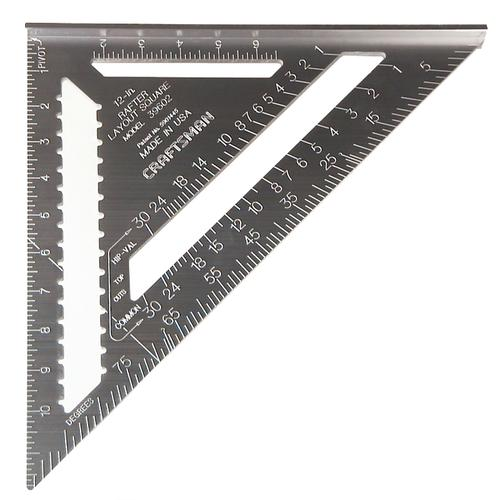
|
Try Square:It is marked in 8ths and 16ths of an inch.
(Measuring, Layout, and Surveying) |
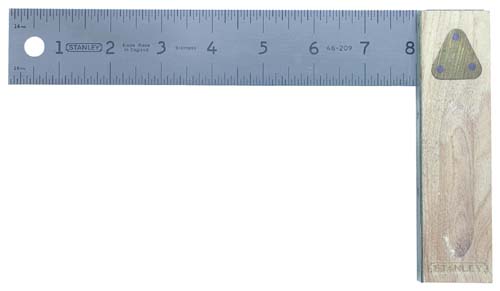
|
Framing Square:Rafter framing squares are marked in 12ths of an inch on the back side. Also called a Carpenter’s or steel square. Many of these squares are inscribed with rafter tables.
(Measuring, Layout, and Surveying) |

|
Combination Square:A level and a scribe are contained in the beam.
(Measuring, Layout, and Surveying) |

|
Depth Gauge:Usually graduated in 32nds and 64ths.
(Measuring, Layout, and Surveying) |

|
Sliding "T" Bevel:After it is set at the correct angle, it is much the same as a square.
(Measuring, Layout, and Surveying) |

|
Outside Calipers:The calipers are adjusted to the outside diameter of the object and then laid on a rule where the reading is taken.
(Measuring, Layout, and Surveying) |

|
Dial Caliper:Capacity is from 0 to 6 inches.
(Measuring, Layout, and Surveying) |
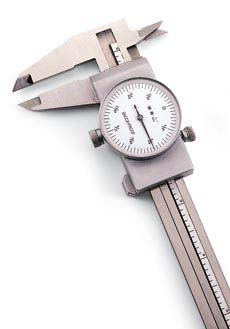
|
Fractional Vernier Caliper: Direct reading of 16ths and 32nds of an inch on the handle, and vernier readings of 1/128 inch.
(Measuring, Layout, and Surveying) |

|
Inside Calipers:The calipers are adjusted to the diameter of the object and then laid on a rule where the reading is taken.
(Measuring, Layout, and Surveying) |

|
Line Level:It consists of a bubble tube housed in a metal or plastic case which has hooks for attaching to the line.
(Measuring, Layout, and Surveying) |

|
Carpenter's Level:Used for marking level lines and for checking surfaces for level and plumb. Typical length 24-48 inches. Longer levels are often called masonry levels since they are commonly used to lay brick.
(Measuring, Layout, and Surveying) |

|
Protractor:It is graduated from 0 to 180 degrees.
(Measuring, Layout, and Surveying) |
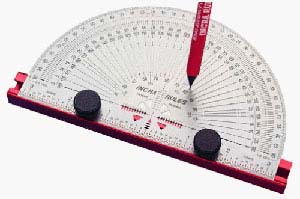
|
Feeler Gauge:Used for gauging the clearance or spacing of valve tappets and other jobs where accurate measurements of .001 to .032 may be desired.
(Measuring, Layout, and Surveying) |

|
Dividers:Used for marking out circles or parts of circles, for transferring or duplicating short measurements, and for dividing distances into a number of equal parts.
(Measuring, Layout, and Surveying) |
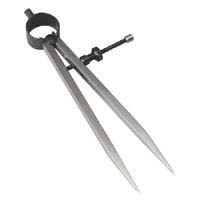
|
Chalk Line:A special container contains the chalk powder and line which is on a winding spool.
(Measuring, Layout, and Surveying) |
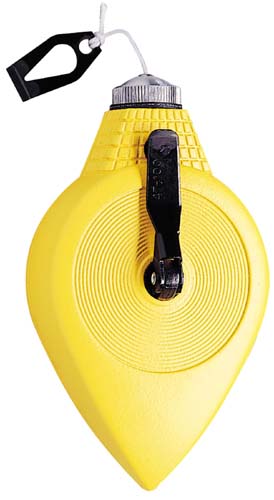
|
Plumb Bob:It can also be used to establish a plumb line in laying brick or concrete blocks. Also used to establish a survey instrument (like a transit) above a specific point.
(Measuring, Layout, and Surveying) |
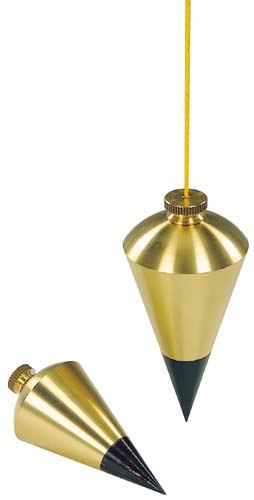
|
Scratch Awls:Also used as a punch for making small holes in light gauge sheet metal for the insertion of sheet metal screws.
(Measuring, Layout, and Surveying) |

|
Soapstone:Unlike chalk, it is hard enough not to mark hands or clothing and can be used in holders that resemble pencils.
(Measuring, Layout, and Surveying) |

|
Scribe:The tip is brittle and will snap off if dropped on the point or used as center punch.
(Measuring, Layout, and Surveying) |
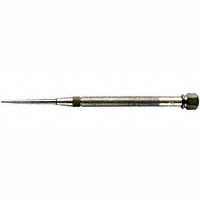
|
Surveyor's Steel Tape:Quite often called a “chain.” These may be stored on a reel or coiled.
(Measuring, Layout, and Surveying) |
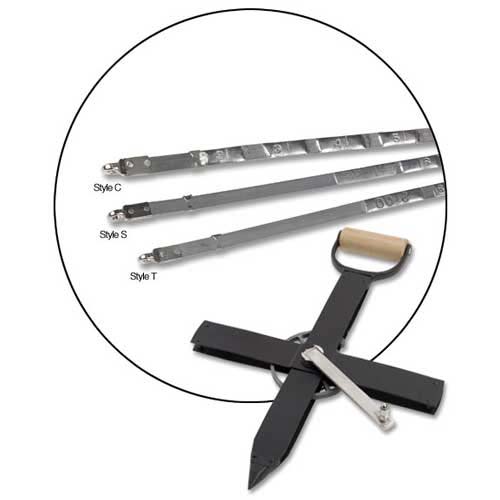
|
Laser Level Receiver:The receiver that detects the laser beam of the laser level. Can be fitted to a Philadelphia or Direct Elevation rod.
(Measuring, Layout, and Surveying) |
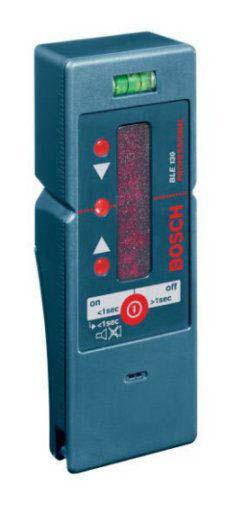
|
Direct Elevation Rod:Rod reads elevations directly (without subtraction from the HI) by used a sliding tape. Some rods have a cut/fill scale for use in grading.
(Measuring, Layout, and Surveying) |

|
Builder's Level:A telescope instrument used to check level of forms or field grades. Builders' levels are designed to be used for short distances. Farm or dumpy levels are similar to builder's levels, but have more powerful telescopes. Farm levels are used for longer distances. Both instruments are leveled manually using adjusting screws. An “auto” level requires less manual leveling and has only three leveling screws.
(Measuring, Layout, and Surveying) |

|
Global Position System Receivers:Commonly called GPS receivers, they used satellites to establish the user’s position (e.g., latitude and longitude). Recreational receivers have an accuracy of 13 m and survey grade receivers have an accuracy of 2 cm. Differential GPS receivers (accuracy 2cm – 1 m) are commonly used in agriculture to map field boundaries, scout fields, and provide tractor guidance.
(Measuring, Layout, and Surveying) |

|
Transit:Similar to a level, but a transit telescope can be tilted vertically to measure vertical angles. Surveyor’s have generally replaced these with “Total Stations”, but transits are still used to measure vertical angles in construction.
(Measuring, Layout, and Surveying) |
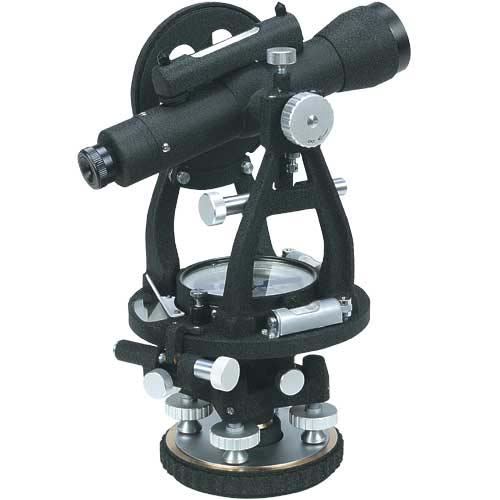
|
Laser Level:A level that used a rotating laser beam to establish a level plane. Leveling can be done with a single person.
(Measuring, Layout, and Surveying) |
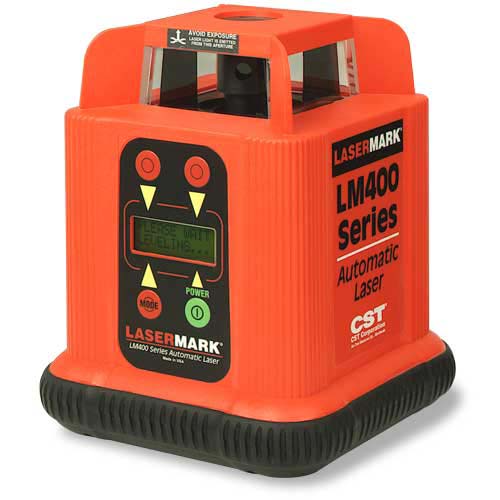
|
Surveyors Arrows:Sizes range from 10 to 14 inches in length. Used to mark distances when "chaining" or measuring distance.
(Measuring, Layout, and Surveying) |
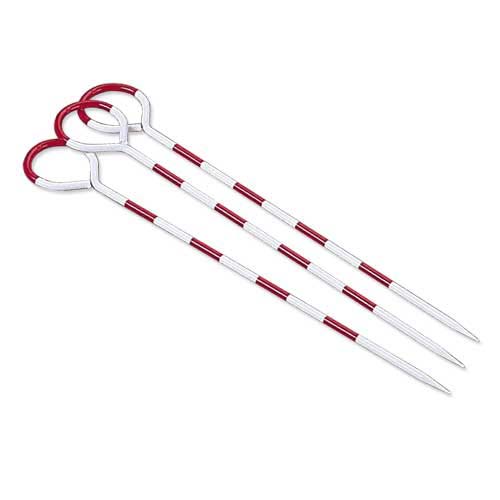
|
Philadelphia Rod:Reads like a tape measure. An adjustable target is available to allow readings up to 700 feet in distance.
(Measuring, Layout, and Surveying) |
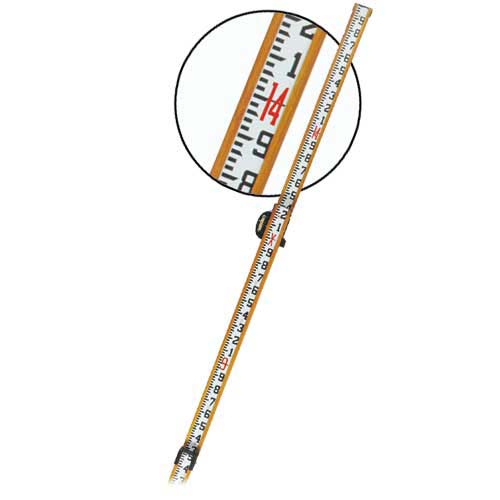
|
Range pole:A simple pole used in lieu of a rod where elevation measurement is not needed.
(Measuring, Layout, and Surveying) |
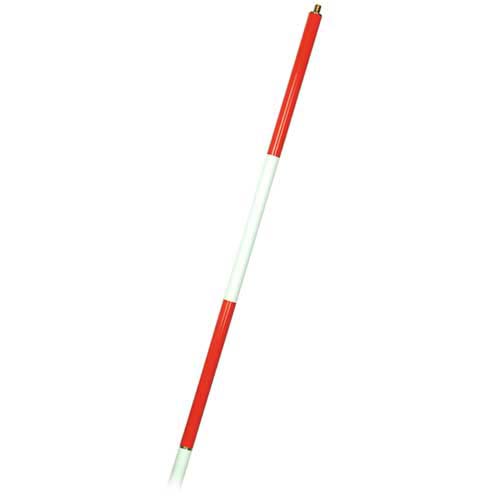
|
Rod Target:Used with the surveyor’s rod to allow readings at a greater distance.
(Measuring, Layout, and Surveying) |

|
Surveying Tripod:Used to hold a level or other survey instrument. To protect threads, keep cap on when not in use.
(Measuring, Layout, and Surveying) |

|
Hand Level:The hand level is held in the hand thus providing little accuracy.
(Measuring, Layout, and Surveying) |
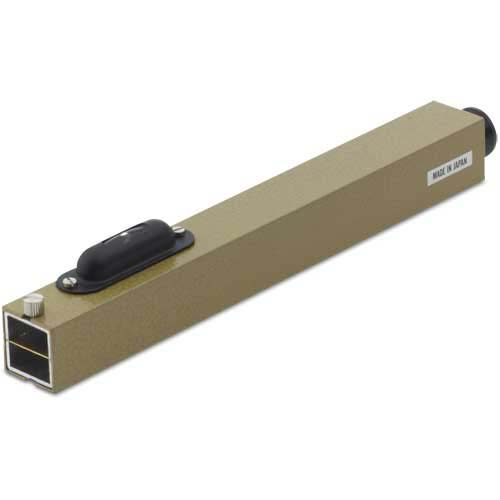
|
Taper Reamer: Used to ream holes for tapered pins used on farm machinery and equipment.
(Metal Working-Tools) |
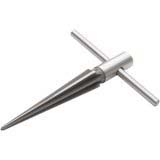
|
Straight Shank Twist Drill:If used on hard steel and at high speeds, it should be made of high speed steel.
(Metal Working-Tools) |
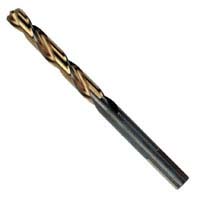
|
Chuck:Used to hold a drill in a drill press or drill motor. May portable drill motors are using keyless chucks that are tightened by hand.
(Metal Working-Tools) |

|
Chuck Key:Used in keyed chuck to tighten or loosen the chuck
(Metal Working-Tools) |

|
Countersink:The shank is 1/4 inch in diameter and can be used in hand or power drills.
(Metal Working-Tools) |
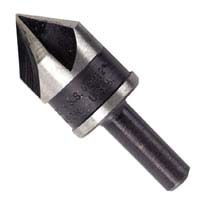
|
Drill Drift:Used for removing morse taper sleeves and tapered shank twist drills from a drill press. Also called a Center Key.
(Metal Working-Tools) |

|
Morse Taper Sleeve:Used as an adaptor to insert different number taper shank twist drills into the drill press.
(Metal Working-Tools) |
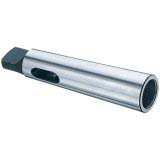
|
Reduced Shank Drills:The shank of the drill comes in three sizes, 1/4, 1/2, and 3/4 inch.
(Metal Working-Tools) |
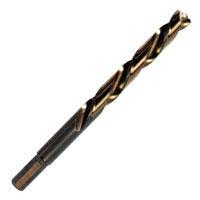
|
Tapered Shank Twist Drill:It should never be used in a chuck.
(Metal Working-Tools) |

|
Diamond Chisel:Use for cutting keyways and groves. Useful for tight places where a cold chisel is too large. Sized by the width of the cutting edge.
(Metal Working-Tools) |

|
Cold Chisel:Size is determined by the width of the cutting edge.
(Metal Working-Tools) |
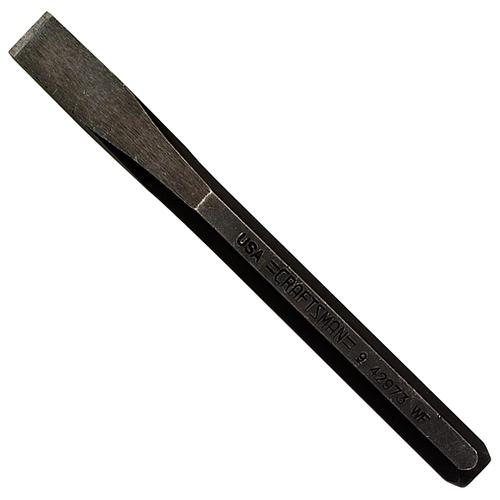
|
Round Nose Chisel:The sides of the shank are flattened and the width at the cutting edge determines the size.
(Metal Working-Tools) |

|
Cape Chisel:Use for cutting keyways and groves. Useful for tight places where a cold chisel is too large. Sized by the width of the cutting edge.
(Metal Working-Tools) |

|
Metal File:Common Shapes: flat, mill, square, half round, round and three square (triangular). Common Coarseness Cuts (rough to smooth): bastard, second cut, smooth. Kinds of Teeth: Single Cut and Double Cut.
(Metal Working-Tools) |
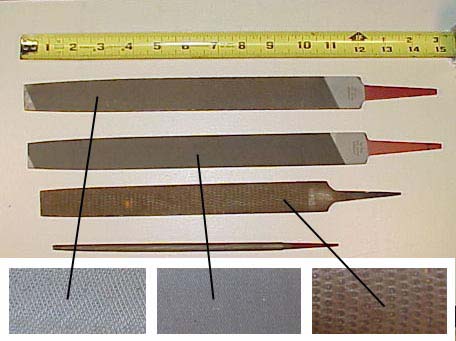
|
Tap Wrench:"T" type tap wrenches have an adjustable chuck.
(Metal Working-Tools) |
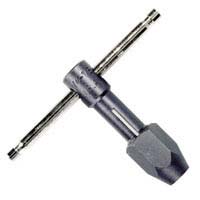
|
File Card:The card is a small fine wire brush.
(Metal Working-Tools) |

|
SAE Tap:Used to cut Society of Automotive Engineers or National Fine threads in bored holes and nuts.
(Metal Working-Tools) |
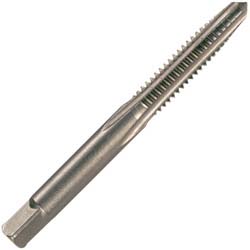
|
USS Tap:Used to cut United States Standard or National Coarse threads in drilled holes or nuts.
(Metal Working-Tools) |

|
Plug Tap:Used to cut threads in machine operations.
(Metal Working-Tools) |

|
Bottoming Tap:Widely used in machine operations to complete a thread in a bottom of a hole.
(Metal Working-Tools) |
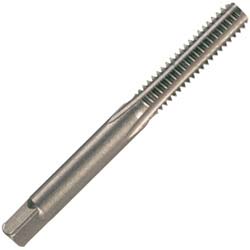
|
Taper Tap:Also used to start threads in a blind hole.
(Metal Working-Tools) |

|
Die Stock:Used as a handle for dies.
(Metal Working-Tools) |
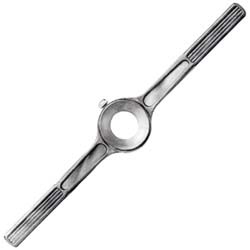
|
SAE Dies:Used to cut Society of Automotive Engineers of National Fine (NF) Threads on bolts.
(Metal Working-Tools) |
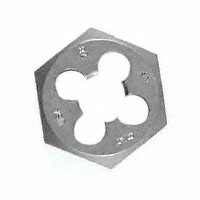
|
USS Die:The die cuts the male thread of a bolt or rod. USS also called National Course (NC) thread.
(Metal Working-Tools) |
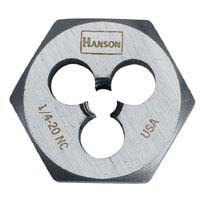
|
Hack Saw:The handle normally has a pistol type grip.
(Metal Working-Tools) |

|
Screw Extractor:A hole is drilled in the center of the broken stud, and the extractor screwed into the hole in a counter clockwise direction. Also called an easy out.
(Metal Working-Tools) |

|
Whet Stone:Used for sharpening tools such as wood chisels and other tools to a fine edge.
(Metal Working-Tools) |
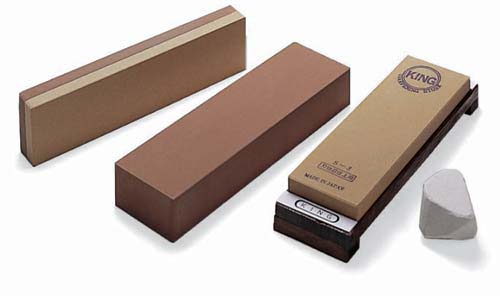
|
Single Cut File:It has a single series of teeth and is made in bastard cut, second cut and smooth type teeth.
(Metal Working-Tools) |
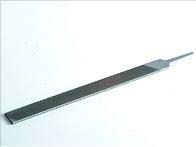
|
Round File:It is available 4 to 16 inches long and 3/16 to ¾ inches in diameter.
(Metal Working-Tools) |

|
Anvil:Sizes range in weight from 20 to 200 pounds. Used to shape cold and hot metal.
(Metal Working-Tools) |

|
Cut Off Saw:Cutting wheels are disposable. Used for cutting steel bar and pipe.
(Metal Working-Tools) |

|
Shear:A powered hand tool used for cutting sheet metal up to 12 gauge.
(Metal Working-Tools) |
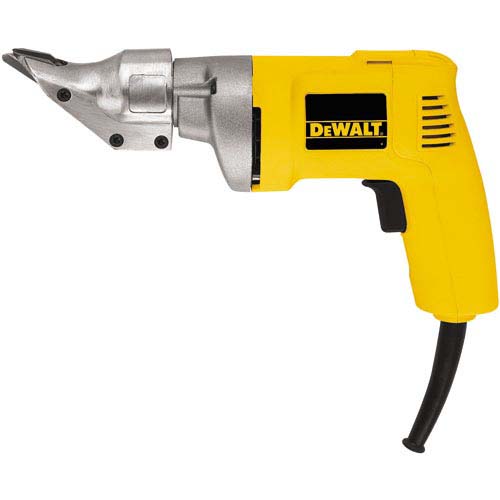
|
Wing Dividers:Divider Tips Are Adjustable By Loosening A Set Screw And Spreading The Tips Apart.
(Metal Working-Tools) |
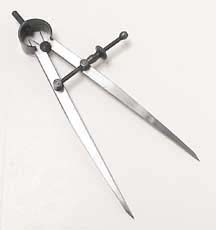
|
Tin Snip:There are four types available; regular straight snip, curved (left and right) snip, and duckbill snip.
(Metal Working-Tools) |
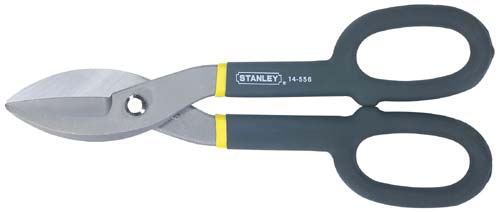
|
Sheet Metal Layout Rule:It also has circumference measurements on the back side.
(Metal Working-Tools) |
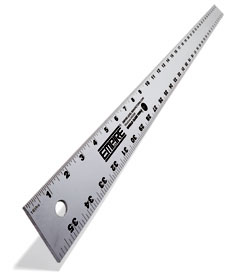
|
Flat Leg Pattern Dividers:Used For Precision Transferring Of Segments From Pattern To Pattern.
(Metal Working-Tools) |

|
Aviation Snips:Available in straight, left, or right. Compound action makes cutting easier and the jaws are usually serrated. Also called Compound snips.
(Metal Working-Tools) |

|
Adjustable Trammel Points:The trammel points can be adjusted to any point on the bar.
(Metal Working-Tools) |
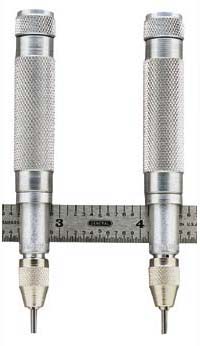
|
Angle Grinder:Available in sizes from 2 to 9 inch. May be used with a grinding, sanding, or wire brush wheel.
(Metal Working-Tools) |
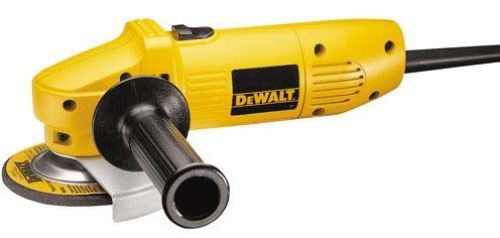
|
Sheet Metal Shear:Foot operated shear
(Metal Working-Tools) |

|
Grinder:Used for sharpening and removing material. Stones are classified by diameter, width, and coarseness (i.e. 1" x 6" 80 grit).
(Metal Working-Tools) |

|
Hydraulic Shear:Powered by a hydraulic pump and cylinder these shears commonly can cut flat stock, angle iron, and punch holes.
(Metal Working-Tools) |
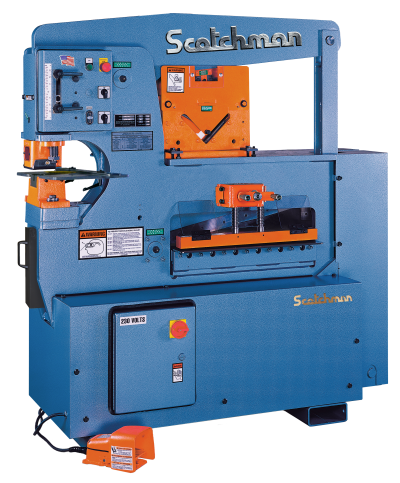
|
Horizontal Band Saw:A band saw designed to cut metal. Typically they have lubrication systems to keep the blade cool.
(Metal Working-Tools) |

|
Fiber Blade:A fiber blade that cuts by abrasion. Typically made with aluminum oxide. Use in the chop saw.
(Metal Working-Tools) |
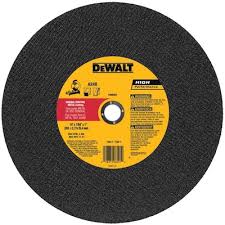
|
Metal Cutting Blade:A circular blade with carbide teeth designed to cut steel or non-ferrous metals.
(Metal Working-Tools) |

|
Box or Pan Brake:Used for bending sheet metal. Has "fingers" in the clamp that allow bends to be made in box shaped projects.
(Metal Working-Tools) |

|
Cornice Brake:Used for bending sheet metal.
(Metal Working-Tools) |

|
Chop Saw:A power saw designed to cut metal. Can be adjusted to make mitered joints.
(Metal Working-Tools) |

|
Sheet Metal Roller:This machine shapes sheet metal into curved shapes. It has three rollers that adjust to control the radius of the bend.
(Metal Working-Tools) |

|
Bender:The tool is used to bend round and square stock, angle iron, and tubing. It is available with many different dies for various shapes. It many be hand or hydraulic powered.
(Metal Working-Tools) |
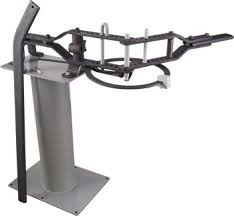
|
Dead Blow Hammer:It does not absorb liquids or produce sparks when striking steel objects. Some models are weighted with lead shot.
(Metal Working-Tools) |

|
Engineer's Hammer:Sizes are form 2 1/2 to 4 pound with handle length of 16 inches.
(Metal Working-Tools) |

|
Ball Pein Hammer:This hammer is constructed with a ball at one end and a round crowned hammering face at the other. Also called a Machinist’s Hammer
(Metal Working-Tools) |

|
Hand Drilling Hammer:The head is made in three different sizes, 2, 3, and 4 pound. It has a short handle and can be used in tight places to drive punches and chisels.
(Metal Working-Tools) |
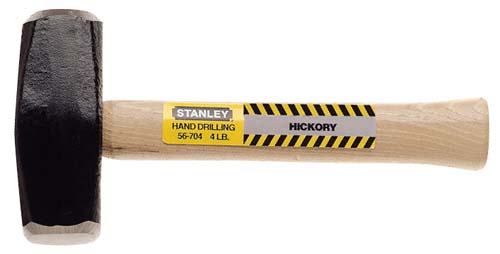
|
Sledge Hammer:Looks like engineers hammer but much larger. 6-12 pounds in weight.
(Metal Working-Tools) |

|
Tinner's Hammer:The hammer head is beveled on one end and has a square face on the other.
(Metal Working-Tools) |
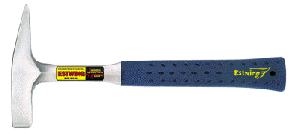
|
Blacksmith's Hammer:The hammering surface is crowned. Designed for use in forming hot metal.
(Metal Working-Tools) |

|
Channel Iron:The common sizes range from 1/2” X 1 inch to 4 X 12 inches.
(Metals) |
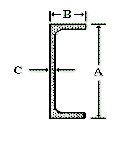
|
Stainless Steel:An alloy steel that resists oxidation. Commonly a chrome or nickel alloy of iron.
(Metals) |
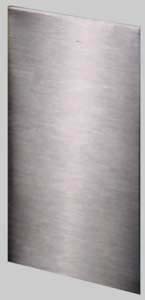
|
Copper:It is sold by the piece, running foot or pound.
(Metals) |

|
Cast Iron: Used to make castings for cylinder blocks, plow bottoms, housings for tractor differentials, transmission cases, sprockets wheels, pulleys, pipe fittings and gears.
(Metals) |
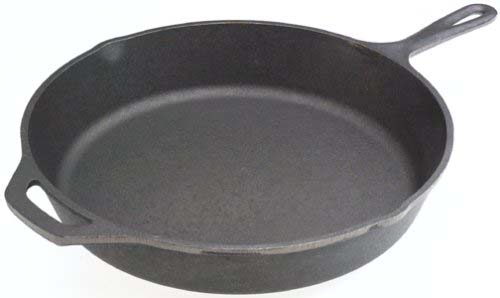
|
Brass:It is sold by the piece or by the pound.
(Metals) |
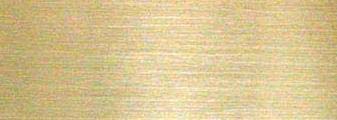
|
Aluminum:It is sold by the square foot, by the piece or by the pound.
(Metals) |

|
Galvanized Steel:The coating varies from 0.0002 inch for the lightest coating to 0.002 inch for water pipe.
(Metals) |
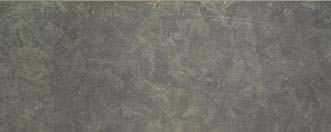
|
Angle Iron:It is sold by the pound. Sized by the length of the legs and thickness. Ex. 2”x2”x1/4”.
(Metals) |
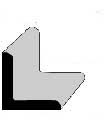
|
Cold Rolled Steel:It is commonly used for making bolts and shafting. Shaped cold the metal is bright and shiny.
(Metals) |
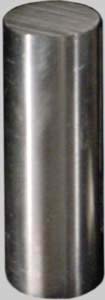
|
Hot Rolled:Available in many shapes. Formed hot the finish is rough and dark.
(Metals) |
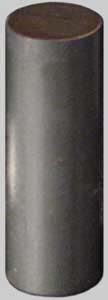
|
Square Bar:Ranges in size from 1/8 inch and greater.
(Metals) |
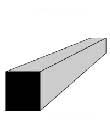
|
Rectangular Tubing:Unequal dimensions (ex. 2"x4") steel tubing. Wall thickness varies from very light ( ex. .080") to thick in larger sizes (ex. 1/2"). Also see square tubing.
(Metals) |

|
Tool Steel:It can be tempered to various degrees of hardness.
(Metals) |

|
Strip Iron:It is 1/8 inch or less in thickness and comes in various widths.
(Metals) |
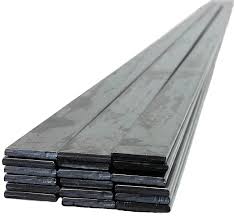
|
I Beam:Used to support structures (placed horizontally). Typical lengths 20-40 feet.
(Metals) |
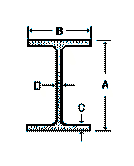
|
Diamond Plate:Sizes range from 1/8 to 1/4 inch thick, 4 to 5 feet in width and 8 to 12 feet in length.
(Metals) |
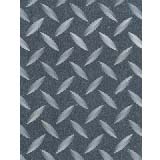
|
Flat Bar:Size is 3/16 inch thick and greater and comes in a variety of widths.
(Metals) |

|
Expanded Metal:Come in gauge thickness and usually 4 to 5 foot width and 8 to 12 foot lengths.
(Metals) |

|
H Beam:A 4 inch H beam is 4 inches wide and 4 inches high.
(Metals) |
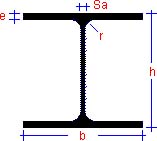
|
Square Tubing:Wall thickness varies from very light ( ex. .080") to thick in larger sizes (ex. 1/2"). Heavier wall tubing is excellent for cultivator tool bars because of its smooth exterior finish and ability to with stand heavy loads.
(Metals) |
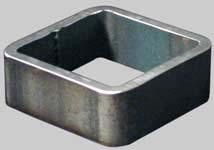
|
Non-woven Abrasive Pads:A plastic abrasive pad. Non-rusting and washable. Commonly called Scotch-Brite pads (3M brand name).
(Painting And Glazing Equipment) |
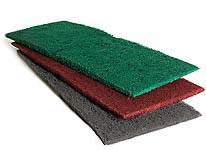
|
Steel Wool:Comes is pads or rolls and size is designated by 4/0, 3/0, 2/0, 1/0, 0, 1, 2, 3, 4, with 4/0 being the finest and 4 being very coarse.
(Painting And Glazing Equipment) |

|
Paint Brush:Natural bristle brushes are used for oil based paints. Polyester and nylon brushes are used with water based paints. Sizes are commonly found from 1” to 6” widths. Clean immediately after using with solvent appropriate for the type of paint used.
(Painting And Glazing Equipment) |
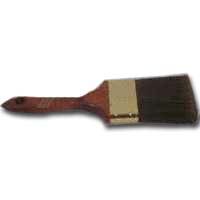
|
Filter:Used to filter foreign material from paints, particularly those used in paint guns.
(Painting And Glazing Equipment) |

|
Caulking Gun:One to two pound cartridge refills are available in various colors.
(Painting And Glazing Equipment) |
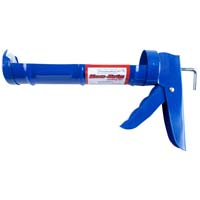
|
Spray Gun:Should be used in a closed area with proper ventilation and good air filtration. Uses compressed air to spray the paint.
(Painting And Glazing Equipment) |

|
Glazier Points:The glazier points, triangular pieces of zinc coated metal, are driven into the sash about 6 inches apart to hold the glass in place.
(Painting And Glazing Equipment) |

|
Putty Knife:Sizes range from 1 inch to 12 inches. Used to apply putty to the window sash to seal the glass. A flexible bladed knife for applying putty and spackle. Stiffer knives can be used for scraping
(Painting And Glazing Equipment) |
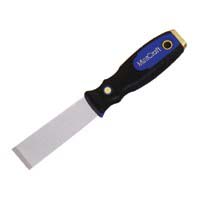
|
Paint Roller And Pan:Special rollers are available for painting corners and trim.
(Painting And Glazing Equipment) |
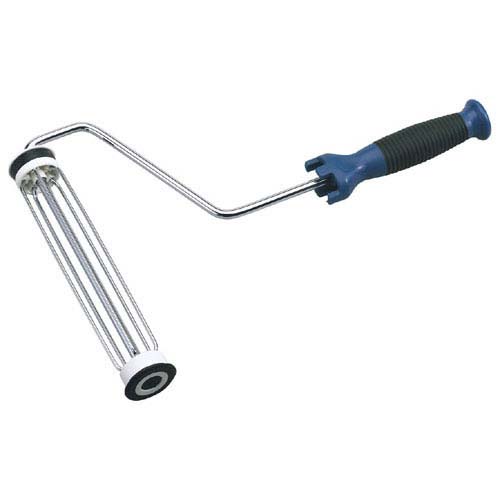
|
Paint Brush:Brushes should be cleaned immediately after painting with a suitable thinner or cleaning agent.
(Painting And Glazing Equipment) |

|
Mixing Paddle:Used in an electric drill to stir paint and other liquids.
(Painting And Glazing Equipment) |
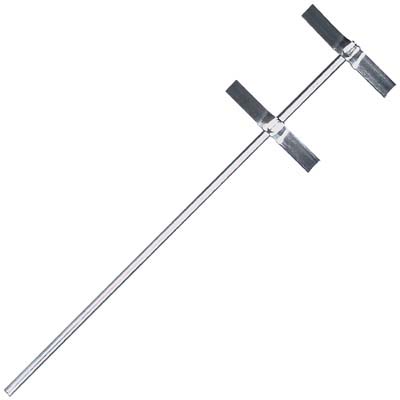
|
Masking Tape:It will adhere to paper, glass, walls and metal and is easily removed.
(Painting And Glazing Equipment) |

|
High Volume Low Pressure Sprayer:Similar in design to an compressed air sprayer, but low pressure produces less fine spray, causes less drift, and air pollution.
(Painting And Glazing Equipment) |
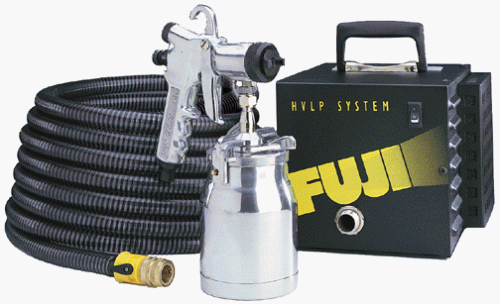
|
Glass Cutter:Pressure applied on the glass from beneath the scratch or tapping gently will cause it to break cleanly along the cutter line.
(Painting And Glazing Equipment) |
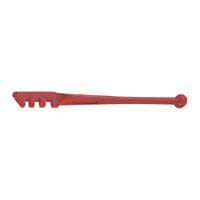
|
Respirator:This filter system is far superior to the dust mask.
(Painting And Glazing Equipment) |
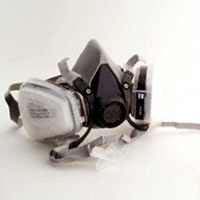
|
Drop Cloth:Disposable cloths are made of paper or plastic and permanent cloths are made of canvas or soft cotton cloth.
(Painting And Glazing Equipment) |
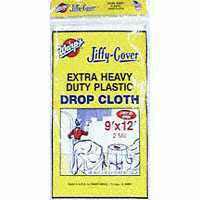
|
Airless Paint Sprayer:No thinning is required and very little over-spray is developed. Uses a positive displacement pump to pump the paint at high pressure.
(Painting And Glazing Equipment) |
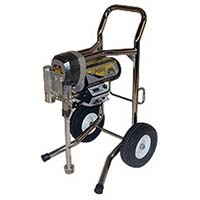
|
Sandpaper:Comes in various grits from very fine to very coarse.
(Painting And Glazing Equipment) |
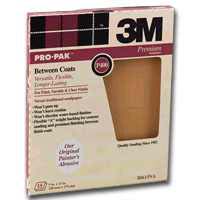
|
Dust Masks:This mask is disposable and should not be reused.
(Painting And Glazing Equipment) |

|
PEX Pipe:Cross-linked polyethylene, commonly abbreviated PEX, XPE or XLPE, is a form of polyethylene plastic. It is used predominantly in buildings (homes),radiant heating and cooling systems, and domestic water piping.
(Plumbing Tools and Supplies - PEX) |

|
PEX Crimp Tool:This tool us used to crimp the metal rings that hold PEX pipe to the barbed fitting.
(Plumbing Tools and Supplies - PEX) |

|
PEX Crimp Ring Remover:Tool is used to remove crimp rings from a fitting.
(Plumbing Tools and Supplies - PEX) |

|
PEX Barb x C:Fitting to adapt PEX to copper pipe. Fitting is soldered onto the copper pipe then PEX tubing is attached.
(Plumbing Tools and Supplies - PEX) |
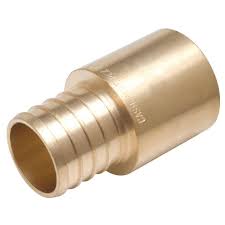
|
PEX Barb x MPT:Fitting to adapt PEX tubing to a threaded (female) fitting.
(Plumbing Tools and Supplies - PEX) |

|
PEX Coupling:Fitting to connect PEX Pipe.
(Plumbing Tools and Supplies - PEX) |
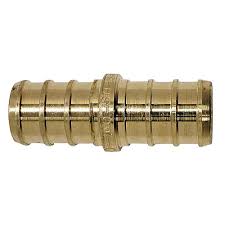
|
PEX Barb x FPT Drop Ear Elbow:The Drop Ear Elbow is mounted on a wall and used to adapt PEX Tubing to a threaded fitting, usually a steel pipe.
(Plumbing Tools and Supplies - PEX) |
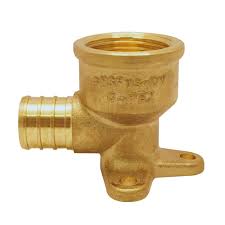
|
PEX Elbow:Elbow fitting. PEX tubing is flexible, but cannot make sharp bends. Elbows are used for this purpose.
(Plumbing Tools and Supplies - PEX) |

|
PEX Stub Out:Stub outs are commonly used in homes for fixture installation such as faucets. The fitting adapts PEX tubing to copper pipe. Typically a compression fitting valve is attached to the stub out.
(Plumbing Tools and Supplies - PEX) |
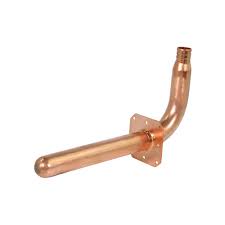
|
PEX Tee:Tee fitting for PEX tubing
(Plumbing Tools and Supplies - PEX) |
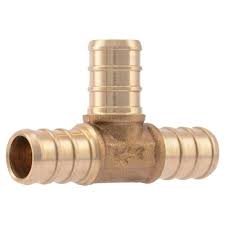
|
PEX Crimp Ring:A metal ring that slides over PEX Tubing. It is crimped over the barb fitting to insure the PEX tubing cannot slide off. Note: There are a number of similar systems for attaching PEX to barbs such as "Cinch Rings".
(Plumbing Tools and Supplies - PEX) |
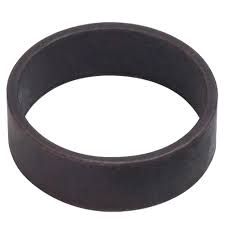
|
ABS Pipe:Acrylonitrile-Butadiene-Styrene (ABS) pipe used for sewer applications. Pipe is black plastic. ABS fittings are glued like other plastic pipe systems. Male and female ends are designated as "spigot" and "hub" respectively. Elbows are not designated by degrees, but rather by the part of the circle (ex. 1/4 bend = 90 degrees). Pipe commonly is found in sizes from 1 1/4" to 6" and 20 foot lengths.
(Plumbing Tools And Supplies-ABS Pipe) |
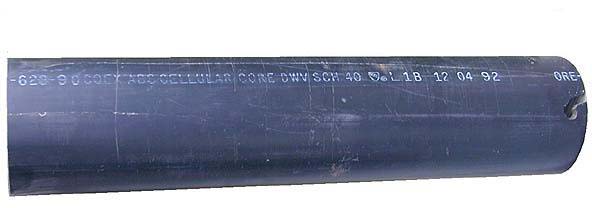
|
Wye Hub:Used for attaching a line at a 45 degree angle to a straight line.
(Plumbing Tools And Supplies-ABS Pipe) |
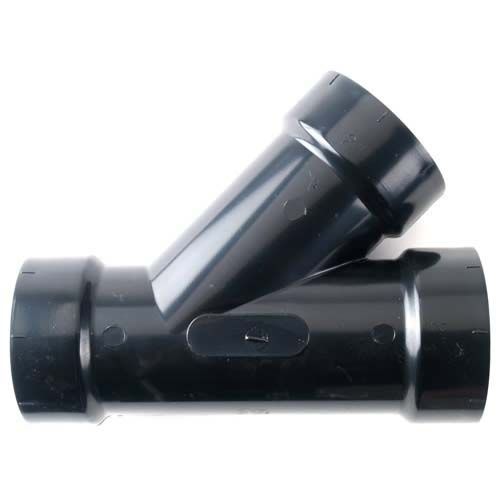
|
P Trap Hub With Union:Liquid is held in the base of the P Trap to prevent the passage of air or gasses.
(Plumbing Tools And Supplies-ABS Pipe) |
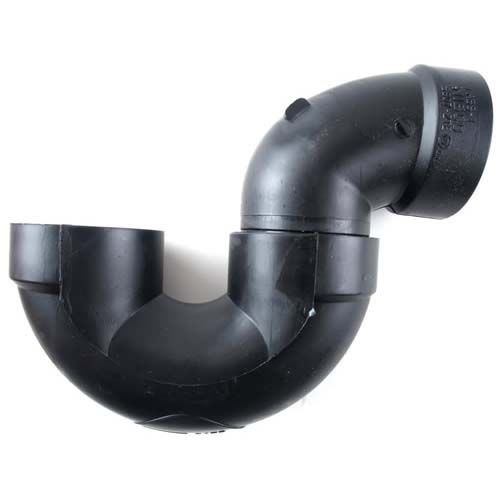
|
Male Adaptor-Hub X Male Pipe:Used to connect ABS pipe to female pipe threads.
(Plumbing Tools And Supplies-ABS Pipe) |
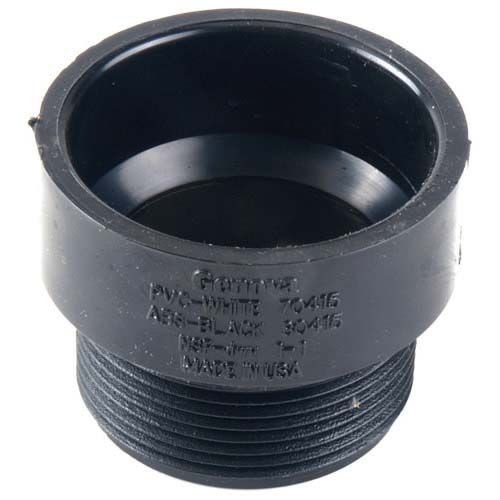
|
Long Sweep 1/4 Bend Hub:Used to connect ABS pipe at a 90 degree angle and allows for easy clean out when using a drain auger or plumbers snake to clean out lines.
(Plumbing Tools And Supplies-ABS Pipe) |

|
Female Adaptor-Hub X Female :Used to connect ABS pipe to threaded pipe.
(Plumbing Tools And Supplies-ABS Pipe) |
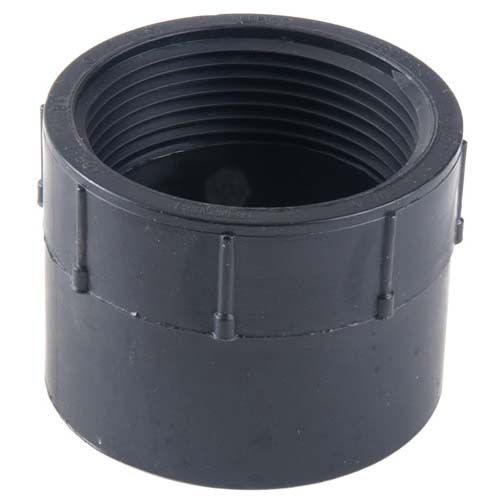
|
Double Wye Hub:Used for connecting two lines at a 45 degree angle to a straight ABS pipe.
(Plumbing Tools And Supplies-ABS Pipe) |
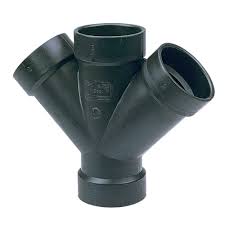
|
Adaptor-Spigot X Female Pipe:Used to connect female ABS pipe fitting to male pipe thread. Often used for cleanouts.
(Plumbing Tools And Supplies-ABS Pipe) |

|
CxC Street Ell:A street elbow for use the copper fittings. Often used with a C x C Ell to make a odd angle.
(Plumbing Tools And Supplies-Copper Pipe ) |

|
Copper Tubing:Flexible tubing used for water applications. Sizes commonly 1/4"-2" O.D. Connections are soldered, flared, or compression type.
(Plumbing Tools And Supplies-Copper Pipe ) |
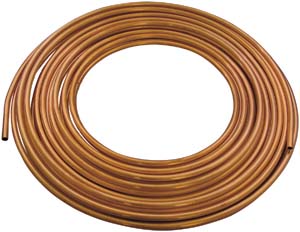
|
Copper Pipe:Rigid pipe used for water supply plumbing. Sizes commonly 1/2" - 2". Connections are soldered. Copper pipe is available in three basic types: Type M is thin-walled, Type L is medium-walled and Type K is thick-walled.
(Plumbing Tools And Supplies-Copper Pipe ) |
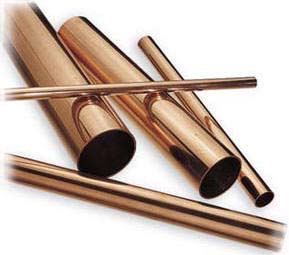
|
CxT Adaptor or Male Adapter:Used to connect copper pipe to threaded pipe.
(Plumbing Tools And Supplies-Copper Pipe ) |
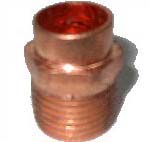
|
C Cap:Used to stop the flow of liquid or gas in a copper pipe.
(Plumbing Tools And Supplies-Copper Pipe ) |
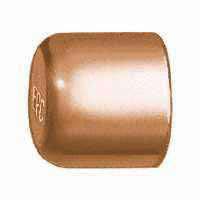
|
CxC Coupling:Used to connect two copper pipes together.
(Plumbing Tools And Supplies-Copper Pipe ) |
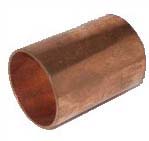
|
CxC Elbow:Comes in 45 and 90 degree angles.
(Plumbing Tools And Supplies-Copper Pipe ) |

|
CxC Reducing Coupling:Used to connect copper pipes of different diameters.
(Plumbing Tools And Supplies-Copper Pipe ) |

|
CxC Union:Used to connect two copper pipes together when neither can be moved.
(Plumbing Tools And Supplies-Copper Pipe ) |
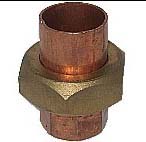
|
CxCxC Tee:Used to connect three pieces of copper pipe together.
(Plumbing Tools And Supplies-Copper Pipe ) |
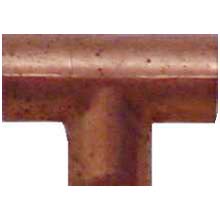
|
CxCxT Tee:Used to connect two copper pipes to a threaded pipe.
(Plumbing Tools And Supplies-Copper Pipe ) |

|
CxT Female Adapter:Used to adapt to female threads
(Plumbing Tools And Supplies-Copper Pipe ) |
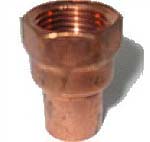
|
Pipe Joint Compound:Used to seal threaded fittings. May be formulated for use with plastic pipe or steel pipe only.
(Plumbing Tools And Supplies-Misc.) |

|
Plumbers Tape:A galvanized flexible steel tape with holes for screws or nails used to secure plumbing. It is cut to length on the job, wrapped around the pipe and secured with a nail or screw.
(Plumbing Tools And Supplies-Misc.) |
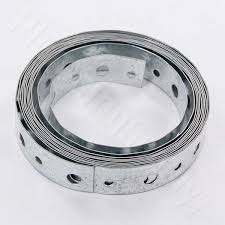
|
Drain Auger:By rotating the auger while feeding it into the line the auger bit tip cuts away the obstruction in the line.
(Plumbing Tools And Supplies-Misc.) |
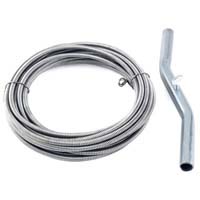
|
PVC Primer:User to clean and soften PVC pipe before applying cement. Generally recommended for pipe 1" and larger.
(Plumbing Tools And Supplies-PVC Pipe) |
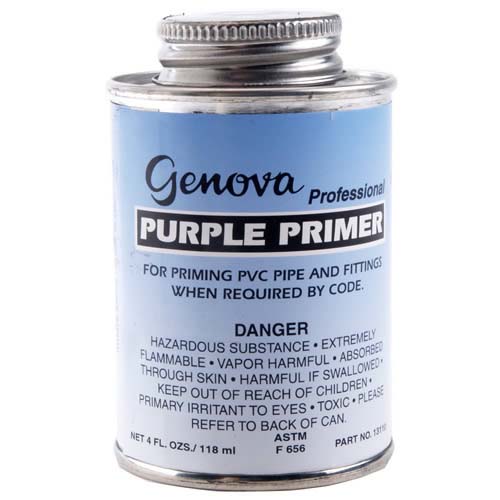
|
PVC Glue:When gluing, apply glue to both the fitting and the pipe, slide the two pieces together and rotate 1/4 turn for good adhesion. Glue is classified by set time and thickness. Small pipe can use light quick setting glue. Larger pipe should use slow setting heavy glue. Some glue is designed to be used on wet pipe.
(Plumbing Tools And Supplies-PVC Pipe) |
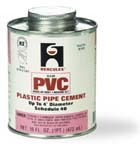
|
S Cap:Used to stop the flow on PVC pipe.
(Plumbing Tools And Supplies-PVC Pipe) |
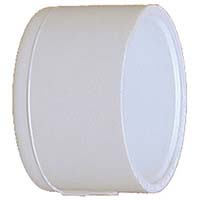
|
SxS Coupling:Used to connect two pieces of pipe together in a straight line.
(Plumbing Tools And Supplies-PVC Pipe) |

|
SxS Elbow:Comes in 45 and 90 degree angles.
(Plumbing Tools And Supplies-PVC Pipe) |

|
SxS Reducer Bushing:Used to connect PVC pipes of different diameters.
(Plumbing Tools And Supplies-PVC Pipe) |
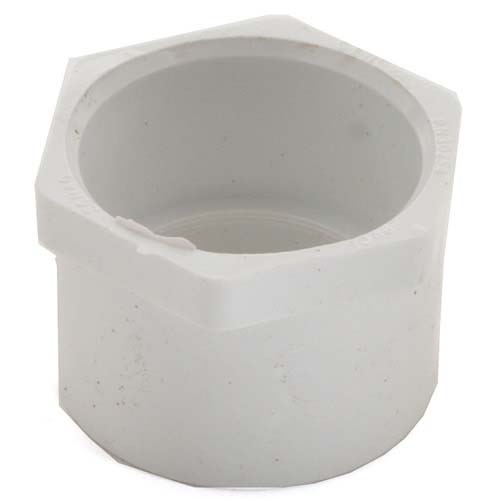
|
PVC Pipe:For domestic purposes, sizes range from 1/2 to 2 inch and it comes in 20 foot lengths.
(Plumbing Tools And Supplies-PVC Pipe) |

|
SxT Elbow:Used to connect PVC pipe to threaded pipe at a 45 or 90 degree angle.
(Plumbing Tools And Supplies-PVC Pipe) |

|
SxS Street Ell:Used to connect two pieces of PVC pipe at an angle.
(Plumbing Tools And Supplies-PVC Pipe) |

|
SxT Reducer Bushing:Used to connect PVC pipe to a smaller diameter threaded pipe.
(Plumbing Tools And Supplies-PVC Pipe) |
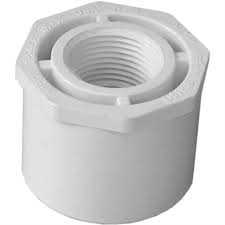
|
SxT Street Ell.:Used to connect PVC pipe to threaded pipe at an angle.
(Plumbing Tools And Supplies-PVC Pipe) |
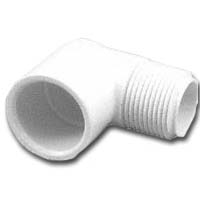
|
Threaded Cap:Used to stop the flow on threaded pipe.
(Plumbing Tools And Supplies-PVC Pipe) |
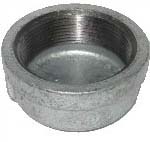
|
SxSxS Tee:Used to connect three pieces of PVC pipe together.
(Plumbing Tools And Supplies-PVC Pipe) |

|
Male Adaptor:The PVC slip end is female and the threaded end is male thread.
(Plumbing Tools And Supplies-PVC Pipe) |

|
Female Adaptor:Used to connect PVC pipe to threaded pipe, has female ends.
(Plumbing Tools And Supplies-PVC Pipe) |

|
Compression Coupling:Can be used on steel or PVC pipe. Usually used for repair or temporary connections.
(Plumbing Tools And Supplies-PVC Pipe) |

|
SxSxT Tee:Used to connect a straight length of PVC pipe to a threaded pipe at an intersection.
(Plumbing Tools And Supplies-PVC Pipe) |
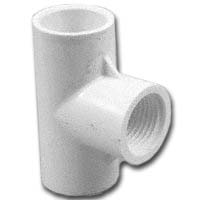
|
Close Nipple:A nipple that is as short as possible (threads touch).
(Plumbing Tools And Supplies-Steel Pipe) |
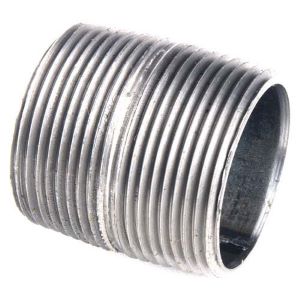
|
Floor Flange:It is a steel flange with female threads in the center and holes drilled on the edge of the flange for bolts or screws.
(Plumbing Tools And Supplies-Steel Pipe) |

|
Galvanized Pipe:Steel pipe with a galvanized coating to prevent corrosion. It Should Not Be Used In Hydraulic Systems.
(Plumbing Tools And Supplies-Steel Pipe) |

|
Tee:Used to connect lateral branches of a pipe.
(Plumbing Tools And Supplies-Steel Pipe) |
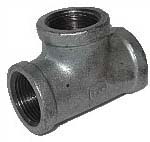
|
Coupling:It is used to connect two pieces of pipe in a straight line.
(Plumbing Tools And Supplies-Steel Pipe) |
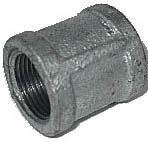
|
Black Pipe:Pipe lines may be constructed with threaded fittings or may be welded.
(Plumbing Tools And Supplies-Steel Pipe) |
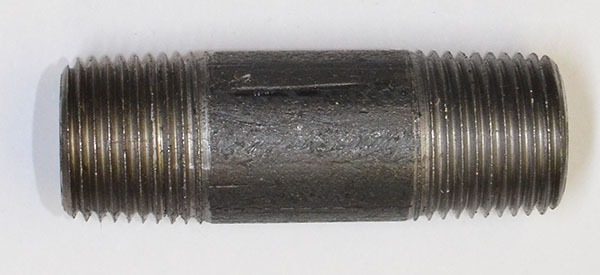
|
Cap:Used to screw over the threaded end of a pipe to stop the opening.
(Plumbing Tools And Supplies-Steel Pipe) |

|
Hose Clamp:It consists of a circular steel collar with a tightening screw to secure the hose in place.
(Plumbing Tools And Supplies-Steel Pipe) |

|
Cross:It is shaped like a cross and is threaded inside at the four ends.
(Plumbing Tools And Supplies-Steel Pipe) |
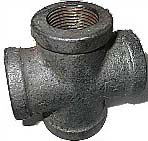
|
Nipple:Short pieces of threaded pipe, nipples are classified as close, short and medium, or are measured in inches of length.
(Plumbing Tools And Supplies-Steel Pipe) |
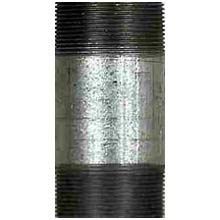
|
45 Degree Elbow:A elbow that changes direction by 45 degrees. Both ends are female threads.
(Plumbing Tools And Supplies-Steel Pipe) |

|
Street Ell:An elbow with male thread on one end and female threads on the other. Available in 90 and 45 degree angles.
(Plumbing Tools And Supplies-Steel Pipe) |

|
Pipe Clamp - Repair Clamp:For 1/2 to 2 inch pipe. Clamps over a hole and seals with a rubber gasket.
(Plumbing Tools And Supplies-Steel Pipe) |

|
Bell Reducer:Similar to a coupling, but changes pipe sizes.
(Plumbing Tools And Supplies-Steel Pipe) |

|
Bushing:One end is hex shaped to receive a wrench.
(Plumbing Tools And Supplies-Steel Pipe) |
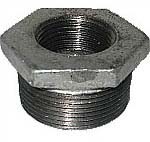
|
Pipe Plug:The end is square to accommodate a wrench.
(Plumbing Tools And Supplies-Steel Pipe) |

|
Union:A three piece fitting. The center piece is hex shaped to accommodate a wrench and tighten the two outer pieces. Used to join two pipes so they can be easily disconnected or join threaded pipe in the middle of a piping run.
(Plumbing Tools And Supplies-Steel Pipe) |

|
90 Degree Elbow:A elbow that changes direction by 90 degrees. Both ends are female threads.
(Plumbing Tools And Supplies-Steel Pipe) |

|
Teflon Tape:Used for sealing threads on metal and PVC pipe and on valves.
(Plumbing Tools And Supplies-Tools) |
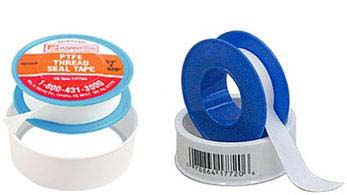
|
Pipe Vise:Used for holding pipe while cutting and threading.
(Plumbing Tools And Supplies-Tools) |
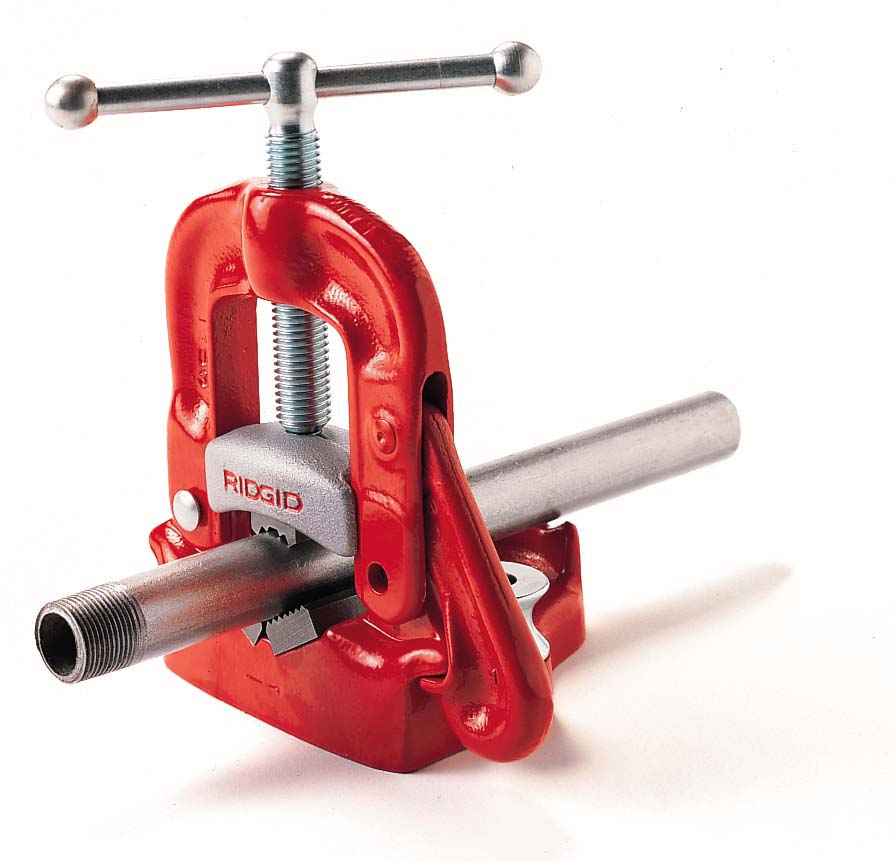
|
Pipe Wrench:Adjustable and is used to turn pipe or conduit or round stock. Sizes 6” – 18” in length are common, but can be much larger.
(Plumbing Tools And Supplies-Tools) |

|
Propane Torch:A propane/air torch that develops temperatures suitable for soldering.
(Plumbing Tools And Supplies-Tools) |

|
Solder:It is available in I or 5 pound spools. Lead free solder is used for plumbing of domestic copper pipe.
(Plumbing Tools And Supplies-Tools) |

|
Tubing Cutter:Used to cut copper and aluminum tubing.
(Plumbing Tools And Supplies-Tools) |

|
Wire Brush:Used to clean metal parts to be soldered or welded and for cleaning pipe threads.
(Plumbing Tools And Supplies-Tools) |
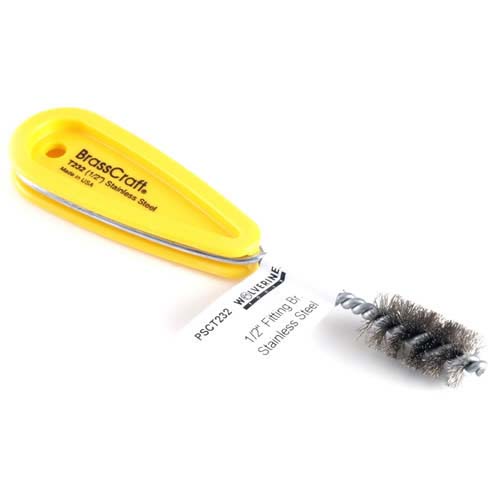
|
PVC Pipe Cutter:This cutter makes smooth clean cuts.
(Plumbing Tools And Supplies-Tools) |
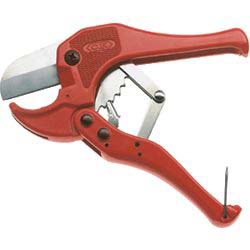
|
Pipe Die Stock:Operates as a ratchet in both directions. Hold the pipe die.
(Plumbing Tools And Supplies-Tools) |

|
Pipe Tap:Used to cut internal threads in pipe fittings.
(Plumbing Tools And Supplies-Tools) |

|
Flaring Tool:Used to make flared ends for soft tempered tubing.
(Plumbing Tools And Supplies-Tools) |

|
Pipe or Burring Reamer:This type of reamer is made with bit brace shank, round shank, or “T” handle.
(Plumbing Tools And Supplies-Tools) |
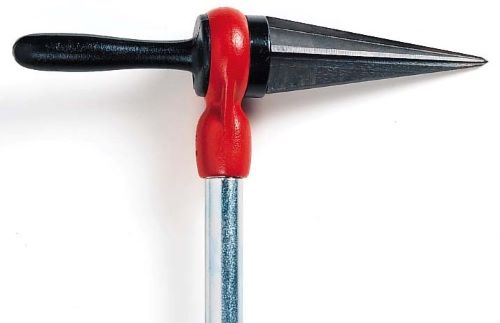
|
Acid Brush:Used for applying pipe joint compound on threaded pipe and tinner’s fluid (acid) or flux on copper pipe for soldering. The handle is tubular sheet metal 3/8 inch in diameter and 6 inches long.
(Plumbing Tools And Supplies-Tools) |
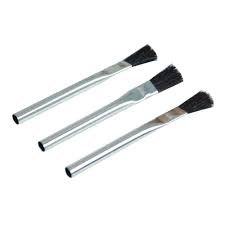
|
Pipe Cutter:Too much pressure on the handle may cause the cutting wheel to break.
(Plumbing Tools And Supplies-Tools) |
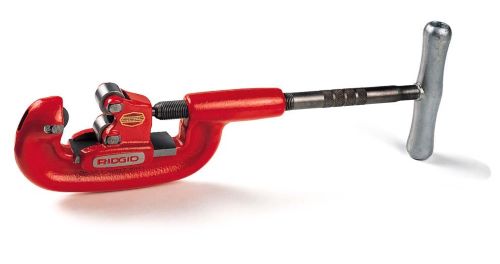
|
Pipe Die:Pipe dies should not be used for bolt threading as they are tapered.
(Plumbing Tools And Supplies-Tools) |
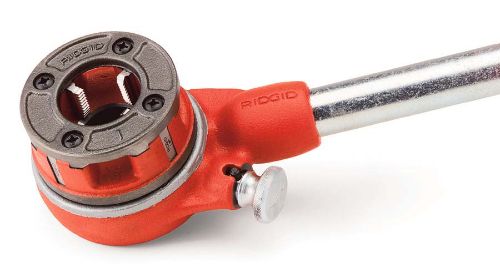
|
Gate Valve:The flow is stopped when the wedge or gate is lowered into the seat.
(Plumbing Tools And Supplies-Valves) |
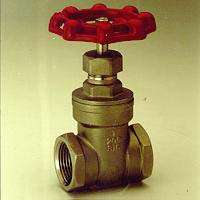
|
Globe Valve:The flow is stopped when the handle is screwed in, forcing the disk over the vent.
(Plumbing Tools And Supplies-Valves) |

|
Cock Valve: Used to stop the flow of liquid or gas through a pipe. Also called a Stop Cock
(Plumbing Tools And Supplies-Valves) |
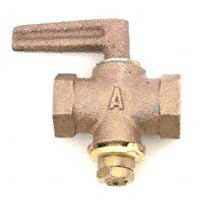
|
Check Valve:Once liquid has passed through the valve it cannot flow back.
(Plumbing Tools And Supplies-Valves) |
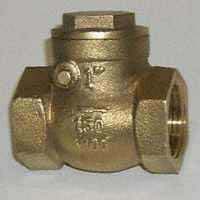
|
Ball Valve:By rotating the ball with the handle the valve closes or opens.
(Plumbing Tools And Supplies-Valves) |
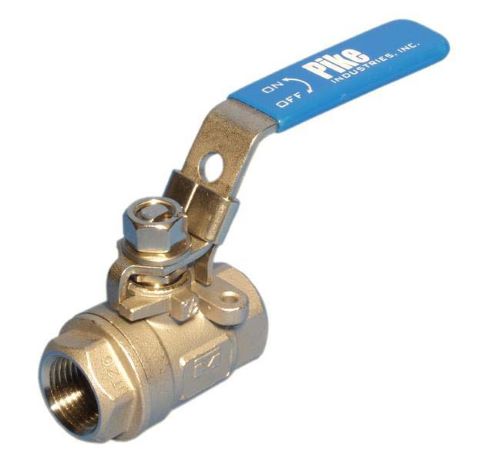
|
Hose Bib:It has standard pipe threads on one end and hose coupling threads on the other.
(Plumbing Tools And Supplies-Valves) |
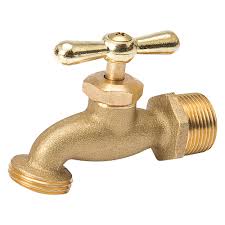
|
Compression Gauge :Ranges from 0 to 300 pounds.
(Power Mechanics - Tools) |

|
Spark Plug Gauge Set:Usually ranges from .020 to .040 thick wire sizes.
(Power Mechanics - Tools) |
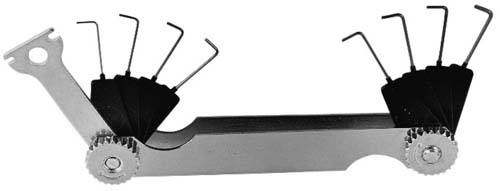
|
Power Timing Light:Operates on 6 or 12 volt DC producing a blue-white flash for reading of timing mark.
(Power Mechanics - Tools) |
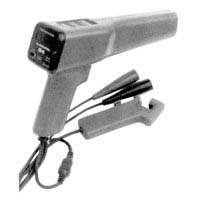
|
Torque Wrench:Comes in 1/4, 3/8, 1/2, and ¾ inch drives.
(Power Mechanics - Tools) |

|
Expansion or Adjustable Reamer: Used for reaming piston pin holes, king pin holes, holes for water pump bushings, valve stem guides and other precision reaming jobs.
(Power Mechanics - Tools) |

|
Impact Wrenches:Available in 3/8, 1/2 and ¾ inch drive.
(Power Mechanics - Tools) |

|
Impact Socket:A 6 point hardened socket designed for use with impact wrenches. Available in standard and deep syyles.
(Power Mechanics - Tools) |
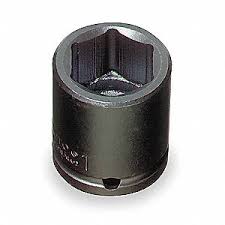
|
Snap Ring Pliers:A tool install and remove internal or external snap rings. May come with interchangeable jaws.
(Power Mechanics - Tools) |
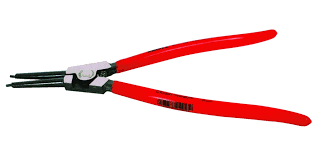
|
Ring Compressor:The ring compressor is used to compress piston rings when installing the piston in the cylinder head.
(Power Mechanics - Tools) |
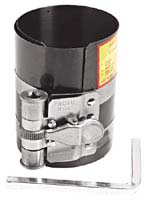
|
Tachometer:Useful for checking speed on tools, machines, and engines.
(Power Mechanics - Tools) |
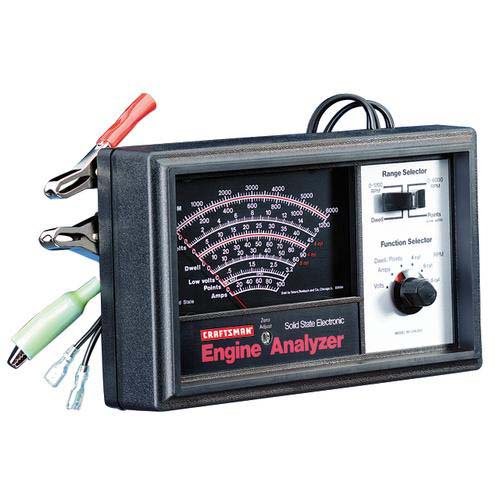
|
Air Pressure Type Grease Gun:It is portable but must be attached to an air line.
(Power Mechanics-Grease Guns And Fittings) |

|
Lever Type Grease Gun:It is filled by hand, cartridge, or from an air pressure gun.
(Power Mechanics-Grease Guns And Fittings) |
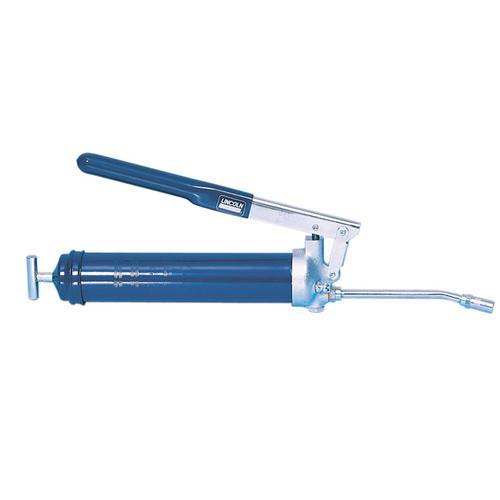
|
Zerk Grease Fitting:This fitting will withstand high pressure. The grease gun "snaps on" to the fitting.
(Power Mechanics-Grease Guns And Fittings) |
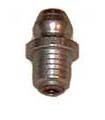
|
Proof Coil Chain:A welded link chain. Chain size is designated by the diameter of the steel used in making the links (e.g.. 3/16"-3/4"). Made from low carbon steel, proof coil is a general utility chain for such uses as tie-down, log chain and assembly tow and switch chain. Available in plain, hot galvanized, and bright zinc finishes.
(Rope and Chain-Chains, Lashing Straps) |

|
Sash Chain:Sash Chain is sold by the foot. Used to hang light fixtures, etc.
(Rope and Chain-Chains, Lashing Straps) |

|
Load or Chain Binder:This devise consists of a handle, two offset links and grab hooks which, when connected to a section of the load-binding chain and the handle pulled, tightens the chain.
(Rope and Chain-Chains, Lashing Straps) |
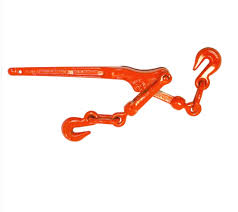
|
Twist Link Chain:Used where the chain must travel easily over something (links don’t get caught).
(Rope and Chain-Chains, Lashing Straps) |

|
Double Loop Chain:Used for tether chains, swings and hammocks and wherever a light inexpensive chain is needed.
(Rope and Chain-Chains, Lashing Straps) |

|
Repair Link:Used to repair a broken chain and for attaching rings and hooks. Also called a Lap Link
(Rope and Chain-Chains, Lashing Straps) |

|
Slip Hook:A round hook used on one end of a log chain to permit it to slip along the chain.
(Rope and Chain-Chains, Lashing Straps) |
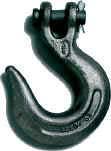
|
Grab Hook:Grab hooks are designed to hook over a chain link and will hold fast when the chain is tightened.
(Rope and Chain-Chains, Lashing Straps) |

|
Swivel:It consists of two chain links connected by a riveted pin.
(Rope and Chain-Chains, Lashing Straps) |

|
Clevis or Shackle: Used for fastening an implement to a draw bar for pulling, fastening a tow cable, and for purposes requiring the fastening or securing of machines or materials.
(Rope and Chain-Chains, Lashing Straps) |

|
Winch:A ratcheting device used to tighten a rope or lashing strap.
(Rope and Chain-Chains, Lashing Straps) |
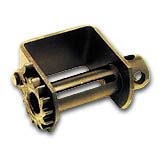
|
Lashing Straps:Used for securing loads. Not used for securing heavy equipment. Typical polyester or nylon strap strength is 10,000-20,000 pounds. Smaller straps are available with a built-in winch. Larger straps are designed to be used with winches mounted on the truck bed.
(Rope and Chain-Chains, Lashing Straps) |

|
Chain Hoist:Sizes are available from 1/2 to 5 ton capacity.
(Rope and Chain-Chains, Lashing Straps) |
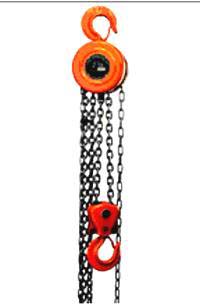
|
Trucker's Hitch:A hitch used for securing a load
(Rope and Chain-Knots, Hitches, Splices) |
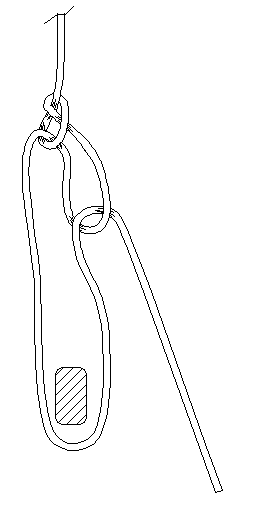
|
Bowline:A knot for making a loop
(Rope and Chain-Knots, Hitches, Splices) |
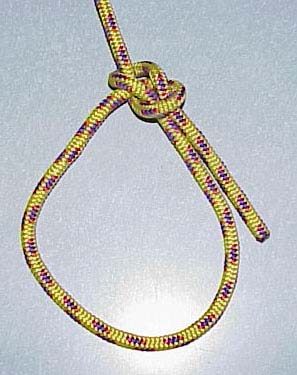
|
Sheet Bend:A knot for joining ropes of different diameters
(Rope and Chain-Knots, Hitches, Splices) |
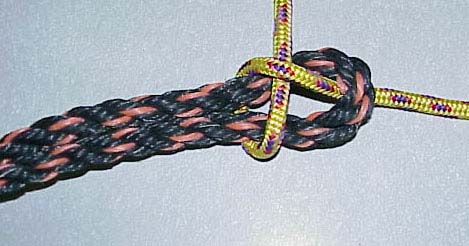
|
Square Knot:A common knot for joining two ropes
(Rope and Chain-Knots, Hitches, Splices) |

|
Clove Hitch:A hitch used to secure a rope to a hook.
(Rope and Chain-Knots, Hitches, Splices) |
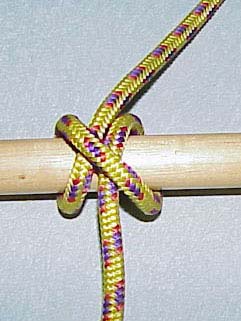
|
Eye Splice:Used to make a permanent loop in a laid (twisted) rope.
(Rope and Chain-Knots, Hitches, Splices) |

|
Cotton Rope:Cotton ropes are soft but the weakest of the natural fiber ropes.
(Rope and Chain-Rope) |

|
Manila Rope:This is a laid (twisted) and comes in three and four strands. A natural fiber, manila is stronger than cotton, but weaker than the synthetic ropes.
(Rope and Chain-Rope) |
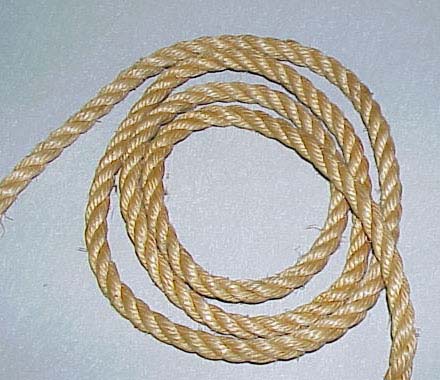
|
Wire Rope Clamps:There are two types, the “U” bolt with cleat and the bolt clamp.
(Rope and Chain-Rope) |

|
Rope Thimble: Used to protect the eye in a rope or cable.
(Rope and Chain-Rope) |
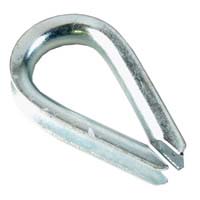
|
Twisted Polypropylene Rope:Keep away from flames and hot metal, it will melt or solidify and break easily. Also called trucker's rope which is generally black with an orange stripe.
(Rope and Chain-Rope) |

|
Wire Rope:To coil or uncoil, roll the rope like a steel hoop.
(Rope and Chain-Rope) |

|
Nylon Rope:Maybe manufactured as a laid (twisted) rope or a braided rope. Stronger and more expensive then poly rope. Braided rope does not have individual strands therefore it is not suited for hand braiding.
(Rope and Chain-Rope) |
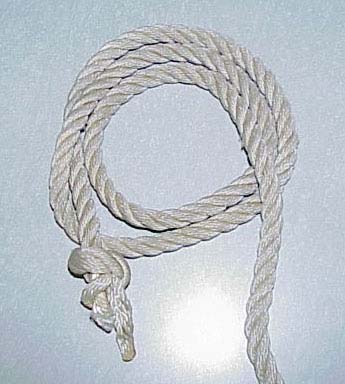
|
Tubular Wire Electrode:Tubular electrode (e.g. E-70T-L) is flux cored., and the last number is position and usability capabilities, as no gas is required for tubular flux cored rod. See Solid Welding Wire Electrode. Also called innershield wire since the shielding flux is "inside".
(Welding-Arc Welding Electrodes) |

|
Solid Welding Wire Electrode:Identified in a similar manner as SMAW rod . For example ER-70S-4. Solid wire is classified in a ER means it is an electrode, 70 is tensile strength, S means it is solid wire, 4 is type of shielding gas. Shield Gases: 2. C02A-O,A-C02, 3. C02A-O,A-C02, 4. CO2, 5. CO2, 6. C02A-O, 7. C02A-O,A-C02 and C02=Carbon Dioxide, C02A-O=Carbon Dioxide, Argon and Oxygen, A-CO2 = Argon and CO2
(Welding-Arc Welding Electrodes) |

|
SMAW Electrode:Electrode used in the SMAW process for example E-6010. E meaning it is an electrode, 60 means it has a tensile strength of 60,000 PSI, 1 indicates welding in all positions, 0 indicates the coating to be cellulose sodium and the welding current is DCEP or direct current electrode positive
(Welding-Arc Welding Electrodes) |

|
Hard Facing Electrode:Hard facing rod is not classified by a numbering system. Each manufacturer has their own nomenclature for their particular rod.
(Welding-Arc Welding Electrodes) |

|
Tungsten Electrode:Non-consumable electrode used for GTAW process welding.
(Welding-Arc Welding Electrodes) |

|
Leather Gloves:Gauntlet style gloves are recommended.
(Welding-Arc Welding Tools) |

|
Electrode Holder:Connected to the welding cable and holds the electrode for SMAW process welding.
(Welding-Arc Welding Tools) |

|
Welding Helmet:A colored lens filters out harmful light rays. Len shades
(Welding-Arc Welding Tools) |
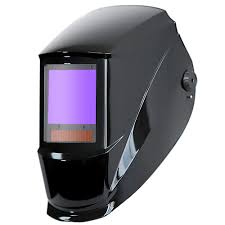
|
Chipping Hammer:One end of the head is shaped with a blunt point, and the other end is shaped like a cold chisel. Also called Slag hammer,
(Welding-Arc Welding Tools) |
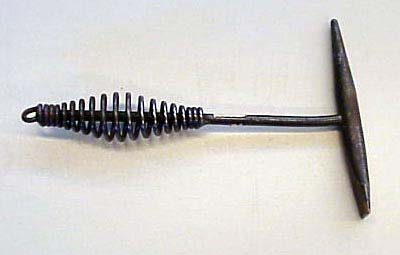
|
GMAW wire feed:Used with a constant voltage power supply and a gas source (e.g. carbon dioxide, argon) for GMAW process.
(Welding-Arc Welding Tools) |

|
Gas Regulator:Used with GMAW and GTAW to control the flow of shielding gas.
(Welding-Arc Welding Tools) |

|
Ground Clamp:Used to connect one of the cable leads from the welding machine to the welding table or the material being welded so as to make a complete circuit.
(Welding-Arc Welding Tools) |
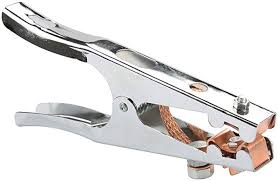
|
Plasma Cutter:Uses an arc and compressed gas to create a plasma stream for cutting and gouging of ferrous and non-ferrous metals.
(Welding-Arc Welding Tools) |
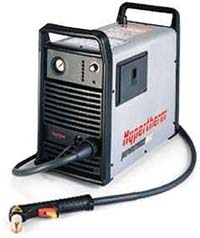
|
GTAW Torch:Holds a non-consumable electrode and directs shielding gas to the weld.
(Welding-Arc Welding Tools) |

|
Arc Welder Power Supply:Converts AC power to welding current. SMAW and GTAW processes use constant current power supplies and GMAW processes use constant voltage power supplies.
(Welding-Arc Welding Tools) |

|
Spot Welder:Used for welding sheet metal.
(Welding-Other Welding Equipment) |

|
Welding Goggles: Used to protect the eyes from harmful rays and from spatter when using the welding torch.
(Welding-Oxyacetylene Welding Tools) |
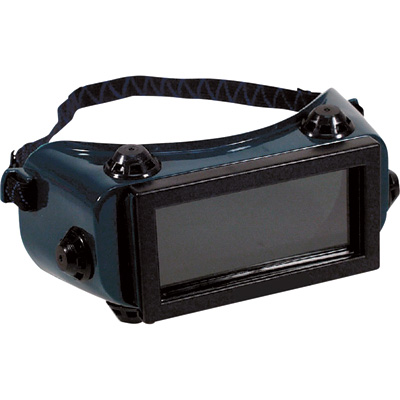
|
Tip Cleaner:It consists of several needle-like round files of different sizes.
(Welding-Oxyacetylene Welding Tools) |

|
Torch Handle:Quite often called a torch butt.
(Welding-Oxyacetylene Welding Tools) |
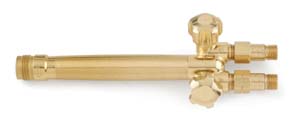
|
Welding Tip:The tips come in various sizes.
(Welding-Oxyacetylene Welding Tools) |
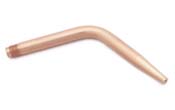
|
Heating Tip:A tip with multiple orifices used to for heating metal usually for bending. Also called a rosebud.
(Welding-Oxyacetylene Welding Tools) |

|
Cutting Tip:The larger center hole is for pure oxygen to oxidize or cut the metal.
(Welding-Oxyacetylene Welding Tools) |

|
Cutting Torch:It consists of valves for mixing oxygen and acetylene, and a valve lever attached to the torch handle to release oxygen which does the cutting.
(Welding-Oxyacetylene Welding Tools) |

|
Brazing Rod:Available in1/16 to 3/16 inch diameter and 36 inches long.
(Welding-Oxyacetylene Welding Tools) |
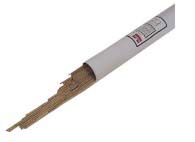
|
Copper Coated Mild Steel :Available in 1/16 to 3/16 inch diameter and 36 inches long.
(Welding-Oxyacetylene Welding Tools) |
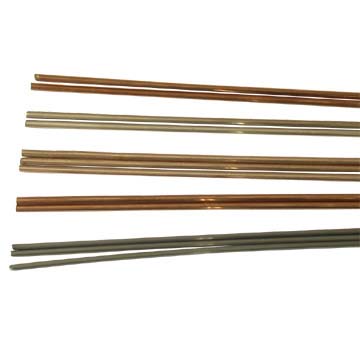
|
Flux Coated Brazing Rod:Generally available in 1/8 inch diameter rod.
(Welding-Oxyacetylene Welding Tools) |

|
Acetylene Regulator:The threads on the hose connector are left hand.
(Welding-Oxyacetylene Welding Tools) |

|
Oxygen Regulator:The threads on the hose connector are right hand. Commonly a two stage regulator.
(Welding-Oxyacetylene Welding Tools) |
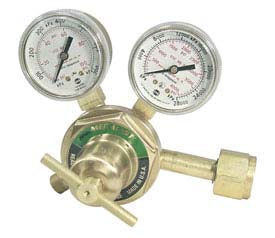
|
Forstner Bit:A power bit for drilling flat bottomed holes in wood. Commonly found in sizes 3/8-2 inch.
(Woodworking-Boring Tools) |

|
Expansive Bit:The shank is a square taper, adapted for the bit brace.
(Woodworking-Boring Tools) |

|
Hole Saw:Hole saws come in sizes from ¾ to 2 1/2 inches and one mandrel fits all.
(Woodworking-Boring Tools) |
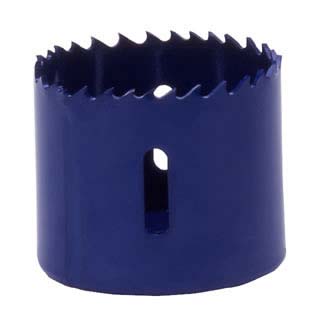
|
Spade Bit:A wood boring bit with a hex shaft to be used in a power hand drill or drill press.
(Woodworking-Boring Tools) |
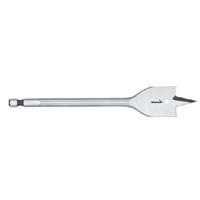
|
Auger Bit:The straight round shank adapted for power drills.
(Woodworking-Boring Tools) |

|
Rotary Hammer:Used for drilling holes in concrete and with chisel attachments. Special carbide tipped bits must be used with this unit.
(Woodworking-Construction) |
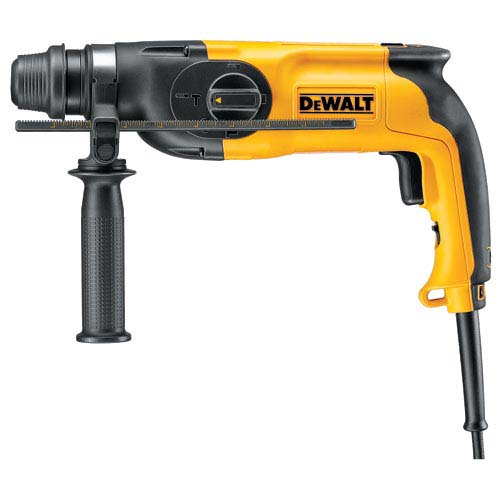
|
Hammer Tacker:A stapler that operates like a hammer. Used to install insulation, builder's paper, roofing felt, etc.
(Woodworking-Construction) |
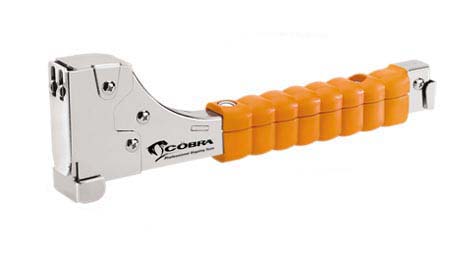
|
Drywall Trowel:A flexible trowel for applying drywall compound and tapping.
(Woodworking-Construction) |
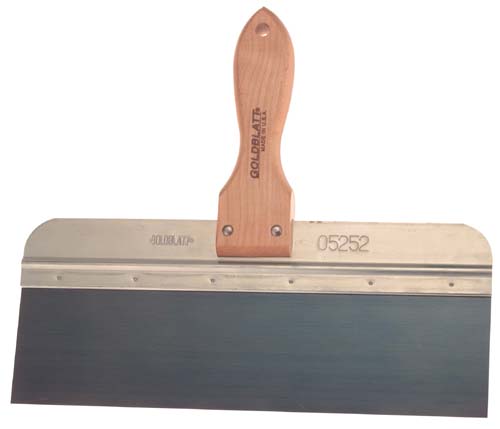
|
Drywall Saw:A tapered hand saw for cutting drywall.
(Woodworking-Construction) |

|
Utility Knife:A sharp knife for cutting drywall, roofing felt, etc.
(Woodworking-Construction) |
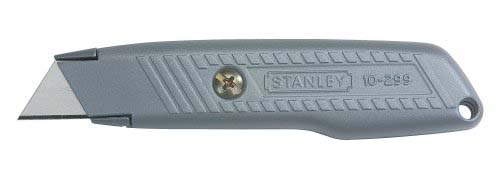
|
Tack Hammer:One side of the head is magnetic and used for starting short tacks.
(Woodworking-Hammers) |
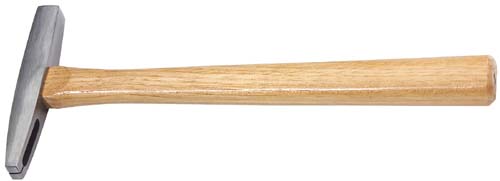
|
Straight Claw Hammer:The hammer head is the same as a curved claw hammer, but the claw is nearly straight. Weight 16-28 oz. Head may be smooth or serrated. Also called a Ripping hammer.
(Woodworking-Hammers) |
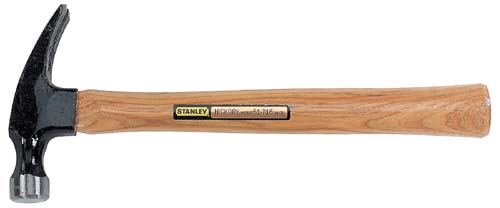
|
Curved Claw Hammer :Used for driving and puling nails. Face is commonly rounded for finish work. Weight 13-16 oz.
(Woodworking-Hammers) |
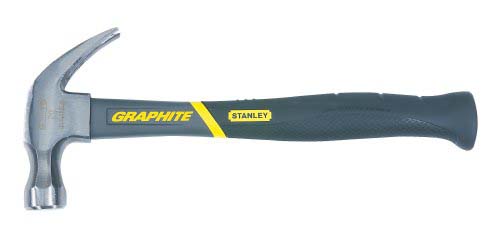
|
Mallet:Heads are made of wood, plastic, rawhide and rubber. Also called a Soft Headed Hammer.
(Woodworking-Hammers) |
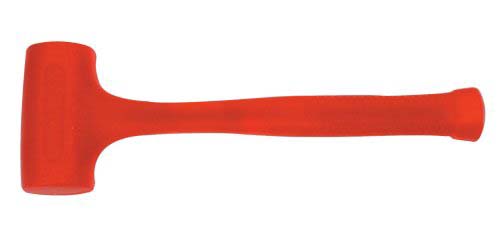
|
Shingler's Hatchet:It has a gauge that can be adjusted for the desired shingle exposure and has a nail pulling slot in the back and above the cutting edge.
(Woodworking-Hammers) |
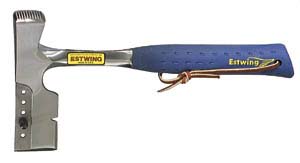
|
Framing Hammer:A straight claw hammer with a serrated head. Typically 20-30 oz. in weight. Used for rough framing of buildings.
(Woodworking-Hammers) |
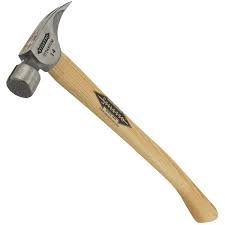
|
Drywall Hammer:A light hammer with a beveled and serrated head designed specifically to install nails in drywall. The beveled head is will countersink the nail head without breaking the drywall paper. The head is slightly angled to aid in driving nails on flat surfaces.
(Woodworking-Hammers) |

|
Spokeshave:A plane designed to shape round shapes like legs (or wheel spokes).
(Woodworking-Planes And Similar Tools) |
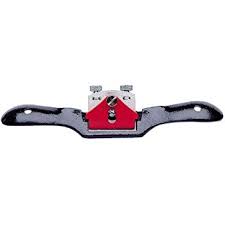
|
Smooth Plane:Sizes range from 5 1/2 to 10 inches long and 1 1/4 to 2 3/8 inches wide.
(Woodworking-Planes And Similar Tools) |

|
Jack Plane:Planing should be done with the grain of the wood. Note tail behind the handle.
(Woodworking-Planes And Similar Tools) |

|
Block Plane:Sizes range form 5 1/2 to 7 inches long and 1 3/8 to 1 5/8 inches wide. Used to plane the end of a board.
(Woodworking-Planes And Similar Tools) |
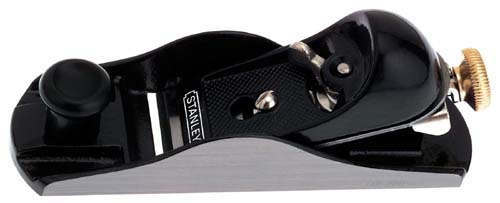
|
Draw Knife:A tool used for rough shaping. The blade is similar to a chisel. They are also a vital piece of equipment in hand-made cricket bats, being used to shape the curve of the bat.
(Woodworking-Planes And Similar Tools) |

|
Cabinet Scraper:A plane designed for smoothing flat surfaces. Similar to a smoothing plane, but the blade has a steeper angle for very fine cutting. Useful for smoothing joints between boards.
(Woodworking-Planes And Similar Tools) |

|
Wood Chisel:It is sharpened only on one side to a 25 or 30 degree angle and may be used with or across the grain.
(Woodworking-Planes And Similar Tools) |
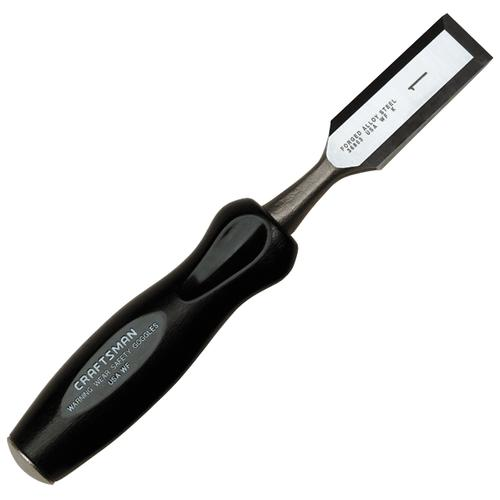
|
Surform Tool:A tool like a wood rasp with a replaceable cutter. Available in flat, round, and half round shapes.
(Woodworking-Planes And Similar Tools) |

|
Cordless Drill/Driver:Comes in many shapes and sizes. These power tools are battery powered and variable speed. They are commonly used for dry wall or decking installation. Many models also have a high speed range for drilling.
(Woodworking-Power Tools) |
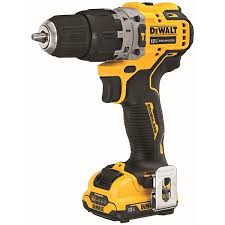
|
Hex Driver Bits:Bit used in impact drivers have this hex drive. Commonly used to drive Phillips, torx, and square drive fasteners.
(Woodworking-Power Tools) |
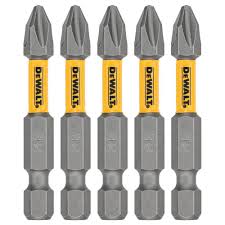
|
Cordless Impact Driver:A power impact driver that accepts hex shank bits.
(Woodworking-Power Tools) |
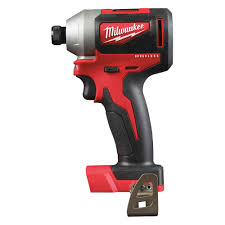
|
Jig Saw:Many variations of blades are available for cutting wood, plastics, and other soft materials. Also called a Saber Saw
(Woodworking-Power Tools) |

|
Surface Planer:Used for planing wood surfaces. A portable power version of a hand plane.
(Woodworking-Power Tools) |
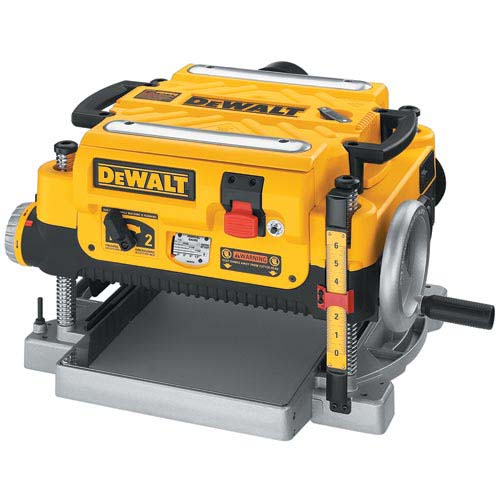
|
Miter Saw:The saw pivots on the miter box for various angles.
(Woodworking-Power Tools) |

|
Electric Drill:Many models are variable speed.
(Woodworking-Power Tools) |

|
Circular Saw Blade:The size is determined by the diameter of the blade.
(Woodworking-Power Tools) |
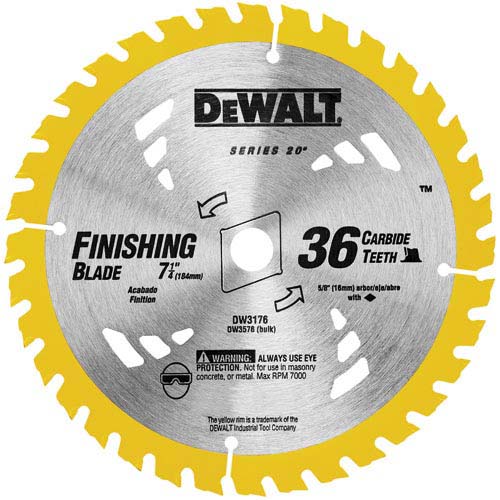
|
Circular Saw:Primarily used for cutting wood, however many blades types are available for cutting sheet metal, metal, stone, and various other products. Available as a direct drive or worm drive.
(Woodworking-Power Tools) |
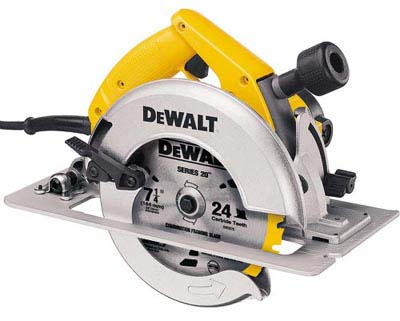
|
Belt Sander:Sands or cuts using a sanding belt. Used for course sanding of large surfaces.
(Woodworking-Power Tools) |

|
Nail Gun:Nails are fed automatically from a loading chamber and are dispensed by pulling the trigger.
(Woodworking-Power Tools) |

|
Reciprocating Saw:Similar to the jig saw but much larger and used for heavy duty work.
(Woodworking-Power Tools) |

|
Finishing Sander:Sands by a vibrating action.
(Woodworking-Power Tools) |
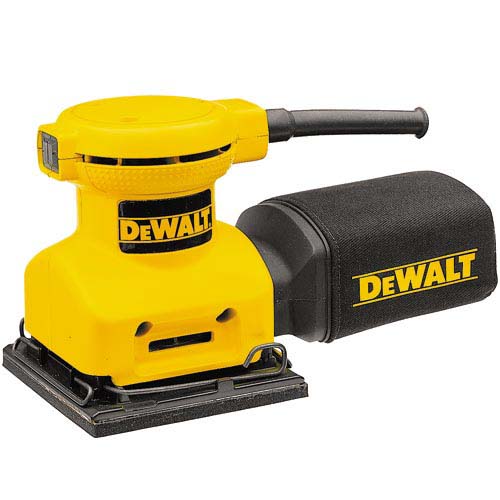
|
Router:Depth of cut is adjustable. Used to shape wood (ex. round the edge of a board).
(Woodworking-Power Tools) |

|
Disc Sander:A stationary power tool with a 6-12 inch sanding disc.
(Woodworking-Power Tools) |
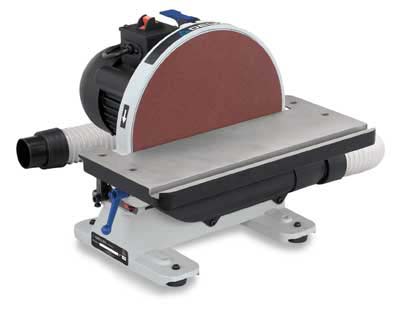
|
Multi-Tool:A power tool (corded or battery) the cuts by high speed osculations. Has interchangeable blades for different materials. Commonly used for flush cutting.
(Woodworking-Power Tools) |

|
Spiral Saw:A saw with a drill like bit (spiral). Similar to a router, but the slim cutter can be used to cut complex shapes. Commonly used for drywall.
(Woodworking-Power Tools) |
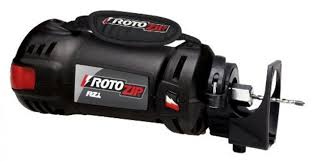
|
Coping Saw:The blade is installed to cut on the pull stroke.
(Woodworking-Saws And Accessories) |
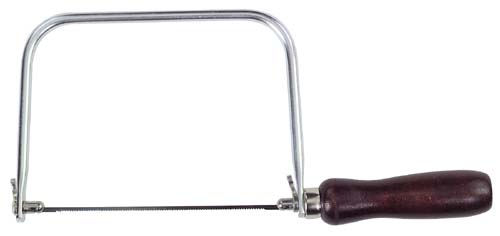
|
Back Saw:This saw should be used in a horizontal position.
(Woodworking-Saws And Accessories) |

|
Keyhole or Compass Saw:Used for sawing curves, especially where the cut must be started from a hole bored with an auger bit.
(Woodworking-Saws And Accessories) |

|
Hand Rip Saw:The edges of the teeth are not beveled, but are shaped like chisels. Typically 4-7 teeth/inch.
(Woodworking-Saws And Accessories) |
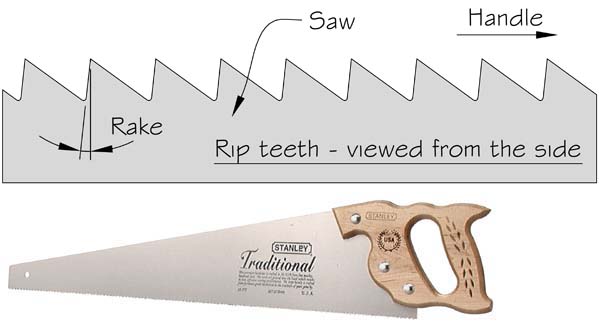
|
Hand Cross Cut Saw:The standard length is 26 inches. Typically 8-12 teeth/inch.
(Woodworking-Saws And Accessories) |
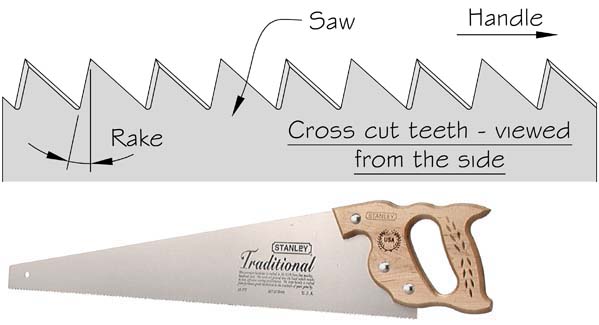
|
Jointer:Stationary machine used to smooth the edges of boards. Power tool that acts like a hand plane.
(Woodworking-Stationary Power Tools) |
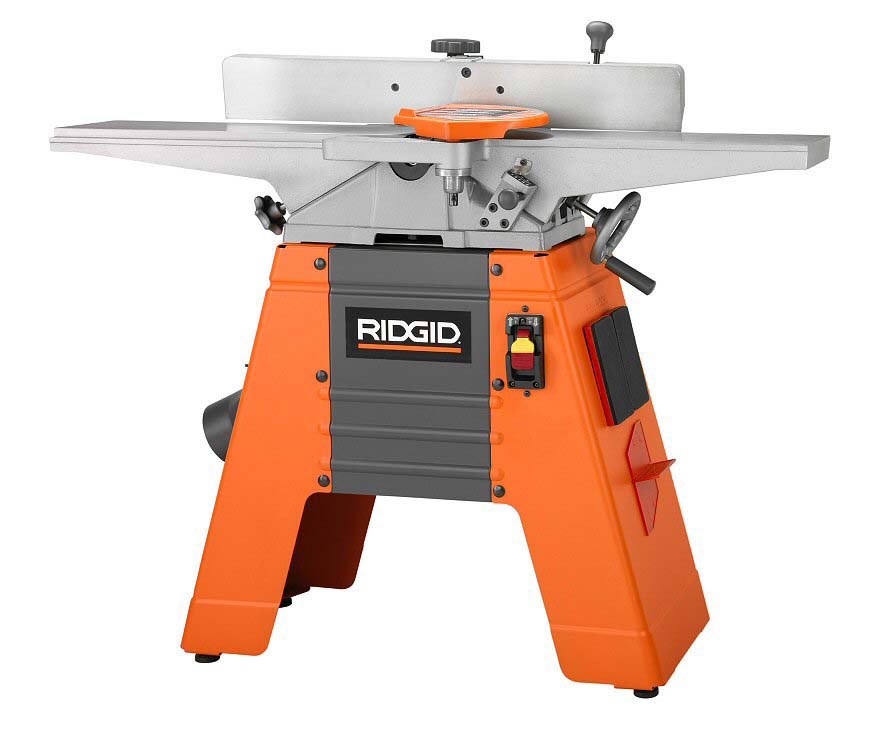
|
Table Saw:A stationary saw used primarily for ripping lumber and sheet materials.
(Woodworking-Stationary Power Tools) |

|
Radial Arm Saw:A saw designed to cross cut and rip with the ability or cut compound angles.
(Woodworking-Stationary Power Tools) |

|
Drill Press:A stationary drill.
(Woodworking-Stationary Power Tools) |
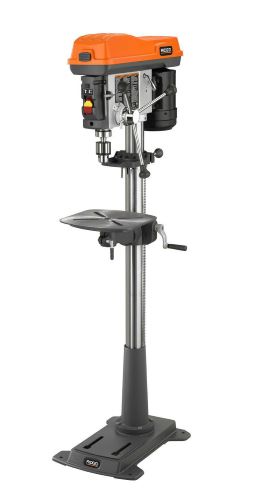
|
Band Saw:Used for making curved cuts in wood or metal.
(Woodworking-Stationary Power Tools) |
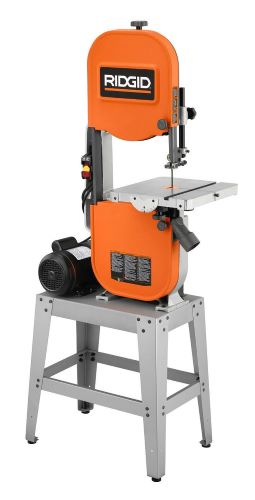
|
Corner Clamp:Jaws are at 90 degree angles. Used to clamp items like cabinet frames.
(Woodworking-Tools) |
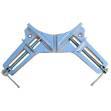
|
Spring Clamp:Jaws are specially formed to hold flat or round objects.
(Woodworking-Tools) |

|
Strap Clamp:Uses a fabric strap that tightens around large or irregular projects.
(Woodworking-Tools) |
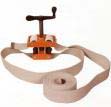
|
Flush Cat Saw:A fine saw used to cut flush to a surface. Commonly used to trim moldings or dowels.
(Woodworking-Tools) |

|
Marking Gauge:It is marked in 8ths and 16ths of an inch and is 8 inches long.
(Woodworking-Tools) |

|
Hand Screw Clamp:The wooden handles are mounted on opposite sides of the jaws.
(Woodworking-Tools) |
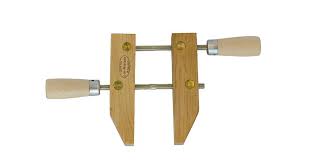
|
Cat's Paw:A tool used to pull nails
(Woodworking-Tools) |
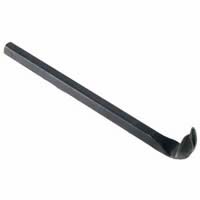
|
Wood Rasp:Other rasps are 4-in-hand and horse rasps.
(Woodworking-Tools) |
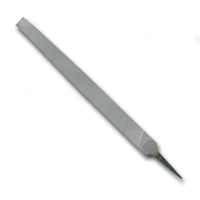
|
Nail Puller:A pair of jaws is driven into the wood below the nail head by impact action of the handle.
(Woodworking-Tools) |
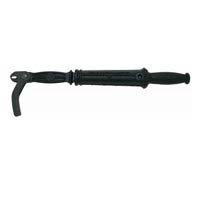
|
Nail Set:The point has a slight hollow at the end.
(Woodworking-Tools) |

|
Cedar:Known for its resistance to decay. Used for fencing.
(Woodworking-Wood) |

|
Redwood:Known for its resistance to decay. Used for landscaping, decking, etc.
(Woodworking-Wood) |
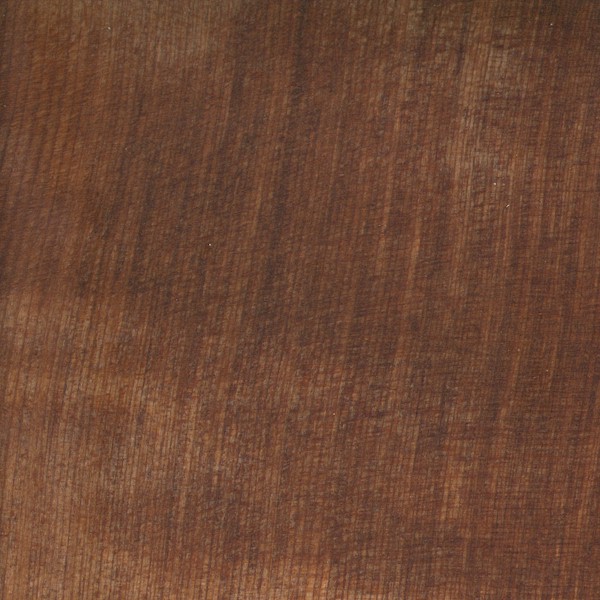
|
Douglass Fir:Used primarily for structural framing. Very strong.
(Woodworking-Wood) |

|
Pressure Treated Lumber:Generally fir species that is treated to resist decay. Green in color.
(Woodworking-Wood) |
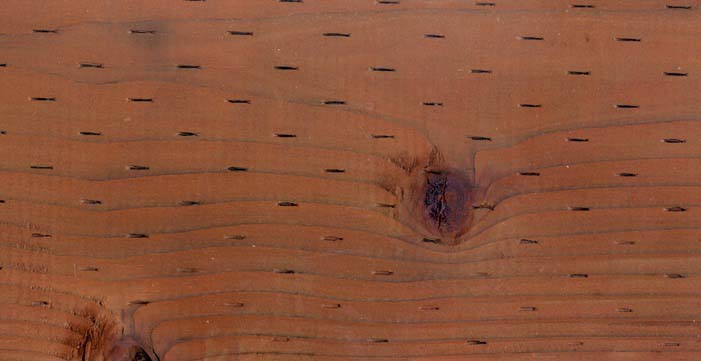
|
Plywood:Composed of layers of wood sheets with the grain of each sheet glued at right angles. Very strong. Used for flooring, roof sheeting, and shear walls. Comes in various grades denoted by letters. A=best, D=worst. For example AC would be A on one side and C on the other. Plywood can be designated as interior or exterior depending on the type of glue used in its manufacture.
(Woodworking-Wood) |
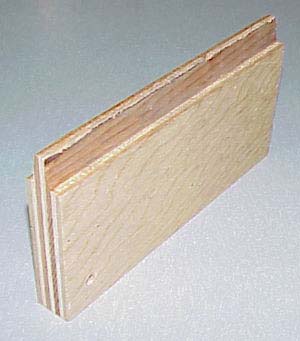
|
Particle Board:Primarily made from sawdust. Used for subfloor where shear strength is not needed.
(Woodworking-Wood) |

|
Medium Density Fiberboard:Medium Density Fiberboard (MDF) is made of wood particles and is denser than particle board. It is use widely as trim (often primed) and for underlayment.
(Woodworking-Wood) |
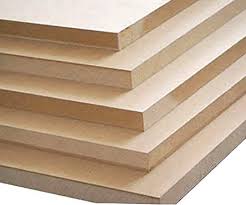
|
Oriented Strand Board (OSB):Primarily made from wood chips. Used for shear walls and roof sheeting
(Woodworking-Wood) |

|
Oak:A hardwood used for cabinets and similar applications. The grain is very distinctive. May be used as a solid wood or as a veneer on plywood or particle board.
(Woodworking-Wood) |

|
Birch:A hardwood used for cabinets, door veneer, and similar applications. May be used as a solid wood or as a veneer on plywood or particle board.
(Woodworking-Wood) |
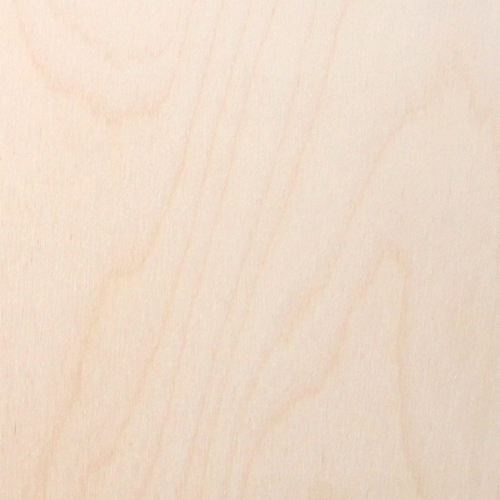
|


























































































































































































































































































































































































































































































































































































































